1942, The Storm
Unrelenting bad weather and a deluge of bombs made a mess out of Malta’s three airfields. Lloyd enlisted the army’s help to not only restore the airfields but to improve them. Through herculean effort, the troops worked 12-hour shifts for the next three months in searing sunlight and in lashing rain. They laid 27 miles of dispersal tracks, built 14 large bomber pens, 170 fighter pens, 70 reconnaissance aircraft pens and 31 naval aircraft pens, using nothing more than sand-filled gasoline cans and sandbags.
On 3 January, the Axis launched a mini-Blitz against the island to cover the passage of an Italian convoy, codenamed M43. With six freighters, the convoy carried a mass of tanks and artillery, plus 3,504-tons of military supplies for Rommel.
Already socked in by bad weather, Malta began to reel under the pressure of the initial Axis attacks. On that day, Pilot Officer Howard Coffin, a handsome, tall American from Los Angeles with slicked-back blonde hair and an immaculate sense of dress, was so intent on plugging an Axis bomber that he failed to notice two Messerschmitt Me109s on his tail. The aircraft were flown by Lt. Gerhard Michalski of 4/JG53 and his wingman.
“They used cannon shells and almost blew my ship out of the sky,” Coffin said. “I was hit in the arms and legs by shrapnel. Gas began pouring out of my tank.”
Coffin pancaked his aircraft at Takali. He remembered a wheel coming off his aircraft and veering off, bouncing along its own trajectory before his world went black. Coffin woke up 24 hours later at Mtarfa Hospital, woozy with morphine and unable to move any of his bandaged limbs.
When the doctor came in, Coffin gave him a look as if to say “what’s with the bandages?” He then exclaimed: “Got a date in Valletta!”

The safe arrival of convoy M43 on January 5 gave Rommel 54 tanks, 19 armored cars, 74 trucks and motor transports, dozens of anti-tank guns, artillery pieces. The delivery of four panzer companies with Panzer IIIs and IVs represented a serious setback for the British 8th Army defending Cyrenaica. But when the British sent a convoy of their own to Malta and deployed Wellington bombers to harass Axis sea lanes, the conversation in Axis circles once again turned to question of invasion.
Hitler remained recalcitrant. He argued for the continued “neutralization” of the island by air, while sending tanks to Rommel to help “recapture the operational initiative.” In the absence of any cogent policy towards Malta, the German Luftwaffe continued to bomb, shoot and kill over Malta, with no end in sight.
As the bad weather finally broke on January 13, the Luftwaffe emerged in strength, savaging the Maltese landscape in an imbroglio of flames, explosions and hot metal which the defending Hurricanes were nearly powerless to stop.

Most Hawker Hurricanes on the island were of the Mark IIB variant, armed with eight machineguns. These aircraft were useless against the German Ju88 bombers which are only marginally slower than the interceptors and were equipped with bulletproof glass and armor plating around the cockpit. “…A lot of our time was taken up by attempting to survive in well-used Hurricane Mk Is and later Mk IIs,” said one frustrated pilot, Sgt. Fred Etchells of 249 Squadron. “On several occasions…to my disgust, I saw an odd Ju88 unescorted and asking to be shot down, but even with all power on and the nose down by 15°, it was able to increase distance between us.”
Group Captain Basil Embry, a technical expert sent by the Air Ministry to assess the situation recommended revamping operational procedures and replacing the Hurricanes with Spitfires. Vice-Admiral Ford complained to Cunningham: “I’ve given up counting the number of raids we are getting. At the time of writing, 4 PM, we have had exactly seven bombing raids since 9 am, quite apart from over a month of all-night efforts… Something needs to be done at once.”
The island was hit by a hundred attacks and 1,800 tons of bombs that January— 800 tons of which had fallen on the airfields, destroying or badly damaging over 50 aircraft. British fortunes on Malta and the Mediterranean are at their nadir and two small convoys sent in January did little to alleviate Malta’s growing food crisis. This prompted Vice-Admiral Ralph Leatham (replacing Ford whose tour had expired) to calculate the island’s first “Target Date” — when the island was scheduled to run out of food and beyond which it will surrender to the Axis. Leatham’s first target date is set in mid-June.
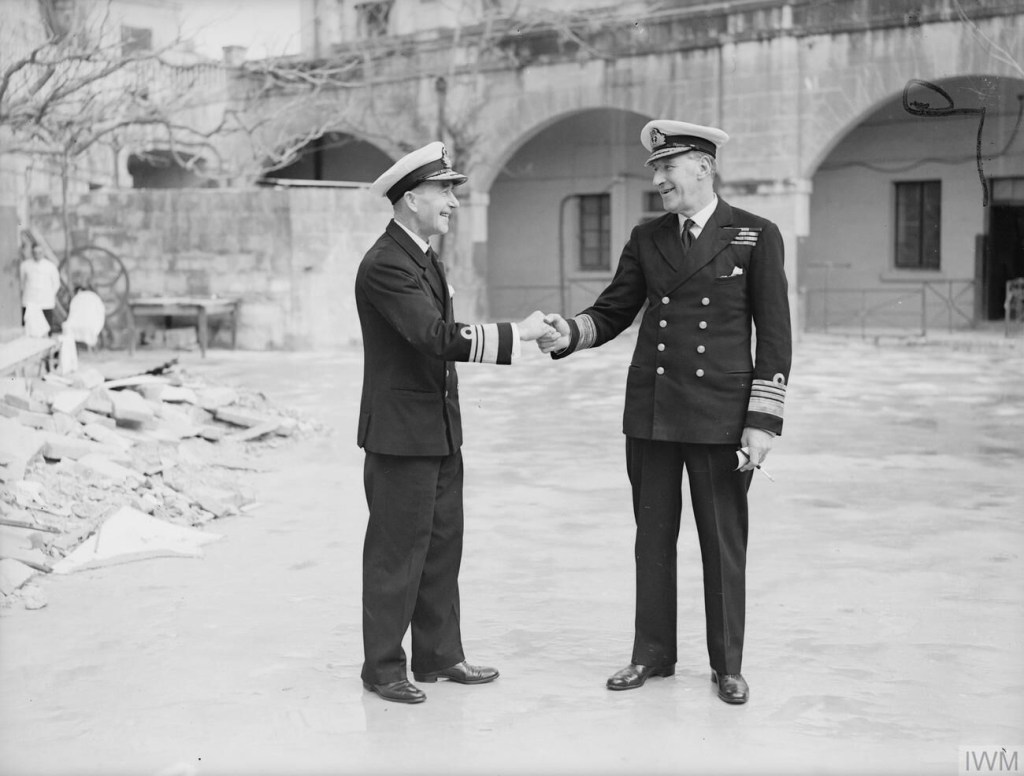
An air battle on January 25 revealed a typical example of Allied air inferiority over Malta. Under orders to protect the departure of two merchantmen, the Glengyle and the Rowellan Castle which were returning to Alexandria, 15 Hurricanes patrolled over the ships that evening. The cargo ships were empty, barring some “40 women and children (service families)” who had been given temporary accommodations in the No 3 hold of Rowellan Castle.
Three Hurricanes from 249 Squadron aborted the patrol because of mechanical problems, including Pilot Officer Harry Moon of 249 Squadron whose engine failed. He was forced to glide back to the airfield to make a “dead-stick” landing, but the rest carried on. Initially, all was quiet, until the ships passed Delimara Point at the southeast of the island, when four Ju88s and a squadron of Me109s materialized out of thin air. Seven Hurricanes from Hal Far throttled up to attack the bombers when the Me109s led by Major Günther von Maltzahn (the commander of Jagdgeschwader 53) bounced eight Hurricanes from 126 and 249 which were tasked with top cover.
“I drew towards them from behind with my five aircraft,” said Major von Maltzahn. “Then coming at them from the rear from out of the sun in wide curves, I set up the first attack against…five Hurricanes…[I] attacked the Hurricane lying on the extreme left. She was hit, went down immediately and broke up into flames into the sea.”
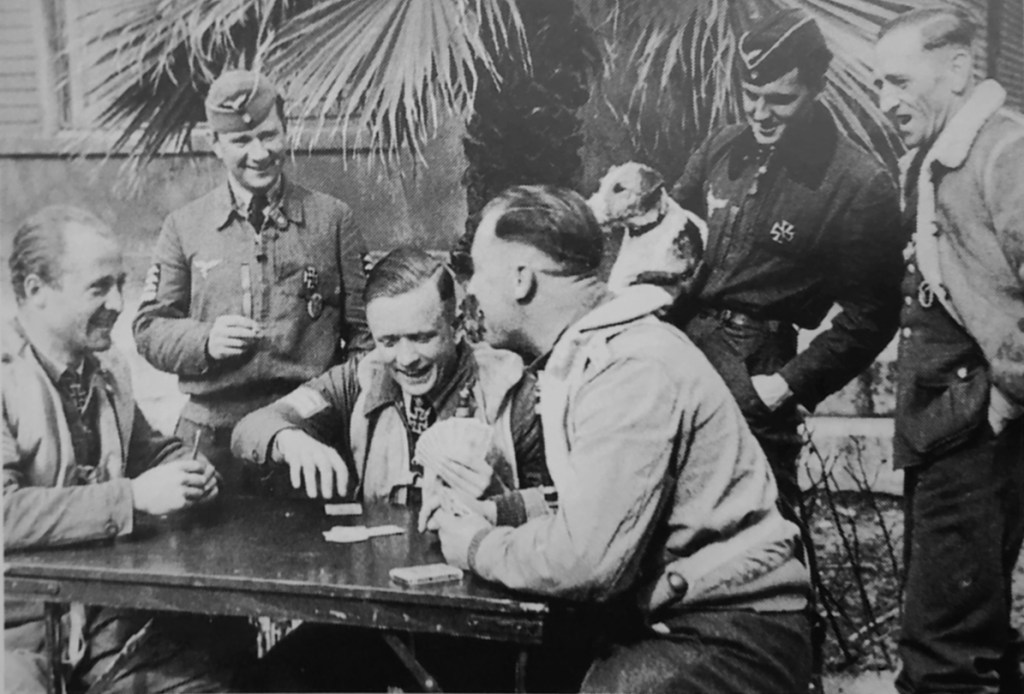
The alarmed Hurricanes increased speed, turned back over land and attempt to out-climb the Messerschmitts. Maltzahn spotted two Hurricanes climbing behind him, presumably to get on his tail. Instead, the two planes flew out over Malta. Their lack of aggressiveness puzzled Maltzahn, but he ignored them and focused on a flight of Hurricanes ahead. He fixed the aircraft on the extreme left in his gunsight and opened fire. His shooting turned the Hurricane into a sieve. The pilot bailed out, hurtling up and over Maltzahn’s Messerschmitt before vanishing from view. Another Hurricane, minus its pilot who had bailed out, flew in rings upside down until it hit the ground.
Having shot down three Hurricanes and damaged one from the top flight, the Messerschmitts then caused havoc among the lower flight, shooting one down and seriously damaging four others. Parachutes blossomed over the island. When the Germans retired, it was as von Maltzahn said: “[a matter of] good luck that we came out of this combat completely unscathed, without a hit.” The overconfident Germans claimed eight Hurricanes shot down, with Maltzahn claiming two and his wingman, Lt. Franz Schieß (Schiess) of Austria, claiming one.

The engagement had been a disaster for the RAF. Several veterans pilots had been shot down, killed or wounded, including: Flight Lt. “Ozzie” Crossey who crash-landed, Pilot Officer John Russel who was killed, Pilot Officer C.A. Blackburn who bailed out wounded, Pilot Officer C.F. Slugget who bailed out unscathed, Flight Lt. “Professor” Thompson who landed wounded and Flying Officer Andy Anderson (nephew of the late, great WWI ace, Albert Ball) who bailed out wounded.
By the start of February, Malta was down to 28 operational Hurricane fighters. The Air Ministry belatedly informed Lloyd of its intention to equip his command with five squadrons of Spitfire. However, the Air Ministry did not give Lloyd a timetable for delivery
In the interim, the island aircraft remained at the mercy of the Messerschmitts, barely able to defend themselves much less protect Malta.
On February 7, the island registered 16 alerts over a 24-hour period — a new record, with the Maltese spending a staggering 13 hours under “alert” status. It was a worrying trend which Lloyd had no means to arrest.
A thousand tons of bombs would be dropped on the island in February as day-by-day, the Hurricane force and its pilots were depleted in an unending battle of attrition. The situation was so desperate that statistically of a flight which took off to intercept the enemy, roughly half returned, often to an airfield which was a smoldering ruin with burned-out aircraft lying on the tarmac. The submarines were similarly unspared.
For nearly a year, the submariners could contend themselves that the Germans did not know where their base was located. A map found in a crashed German bomber in April 1941 had showed that the Germans believed the “U-boothausen” was located at Msida Creek, half a mile away. Simpson had issued orders that the base not advertise itself. The base flew no white ensign and all men in uniform had strict orders to stay out of sight during air raids.
But the Germans had corrected their intelligence error. On 6 February, the Germans subjected the dockyards and Manoel Island to a punishing airstrike.
With typical stoicism, submarine operations continue unabated, but the crew of a new arrival, the Tempest, a T-class submarine were ashen by the scenes of destruction which greeted them upon their advent on February 8.
“The houses and high-piled palaces around Grand Harbor were in many places, piles of rubble now, and a film of honey-colored dust lay upon the sparkling blue of the harbor,” said Chief Petty Officer Charles Anscomb. “The docks were smashed and sunken ships blocked the creeks and the main harbor, waterlogged merchantmen sitting on the bottom, destroyers with their whole bows amputated or sunk in mid-stream with their empty crows’ nests watching a forlorn graveyard of fine vessels. It looked as if Malta was crumbling into the sea.”
As if this were not enough, one of Simpson’s submarine commanders, Lt Desmond S R Martin, compounded Malta’s travails.
When Simpson allowed the Una to embark on her second Mediterranean war patrol on 9 February, he believed he was sending off the boat with an able and experienced skipper in the form of Martin.
Martin had commanded the submarine from the day of her in inception in October 1941. “Martin…I knew and regarded as a sound chap,” Simpson said and it was on this personal feeling that he assigned Una to patrol the approaches to Taranto in that second week of February.
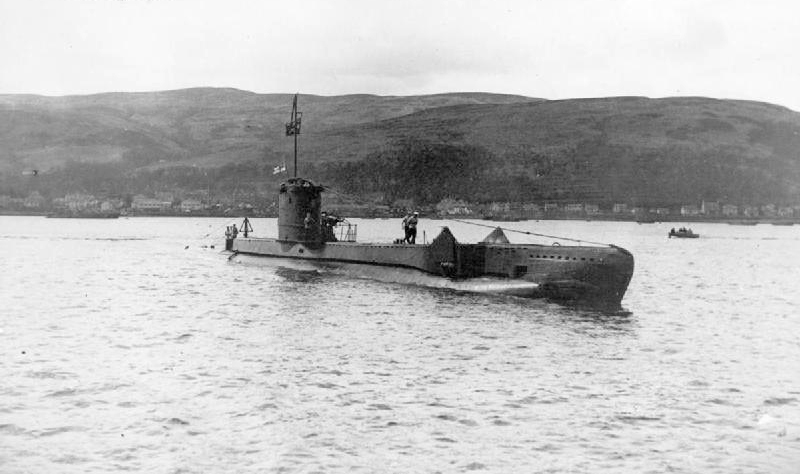
At about the same time, the Admiralty issued an order that the British government had given the 8,100-ton Italian tanker Lucania safe conduct. The tanker’s mission was to deliver fuel to the Italian liner Vulcania which was due to evacuate Italian refugees and civilians from an internment camp at Mombasa in British Kenya. The Admiralty order was passed to all submarines at sea, including Una. “She will not be zigzagging, will not be escorted and will be marked on both sides amidships with the Italian flag… [She] is not to be molested,” the Admiralty order said.

Consequently, at 10.10 AM on the 12th, when Lt Commander Edward Woodward of the submarine HMS Unbeaten spotted the tanker, and recognized her, he let her pass – as did Lt-Commander Napier “Bill” Cavaye of the HMS Tempest. But two hours later, Martin, by now ill with pneumonia, was summoned from his cabin and was told of smoke being sighted to the north. As the Una closed the distance, Martin saw a monoplane aircraft patrolling above the unidentified ship.
Without waiting, Martin launched three torpedoes from a range of 2,600 yards. One torpedo slammed into the Lucania dead-on, resulting in a catastrophic explosion. As the vessel went into her death throes, Martin was perturbed to notice that the ship had “indistinct markings.” When the noises of the explosion reached the Tempest, Cavaye was horrified to see the “untouchable” ship sinking beneath the waves.
The crew of the Lucania sent out a last SOS before the ship went under, as if they could not understand the reason for this British treachery. Even the British Admiralty was incredulous. That same evening, Simpson received a signal from London demanding to know if the Lucania had been sunk. A befuddled Simpson forwarded the message to Una. Martin responded that he had sunk an “unescorted tanker in the morning.” Alarmed, Simpson immediately recalled Una to Malta and assigned Cavaye to take over the patrol area.
Meantime, an angry Supermarina dispatched submarine-killing units to the area. Among them was a veteran submarine hunter, the Spica-class torpedo boat, the Circe. This vessel was made even more lethal by the addition of German S-Gerät (sonar). Under the command of its experienced skipper, Lt-Commander Stefanino Palmas, the Circe angrily thrashed the waters over the site of the now-departed Lucania. Initially the radar scope was clear, but Palmas being the shrewd hunter that he was, waited for darkness to come and for the British to make a mistake. The innocent Cavaye obliged by surfacing after nightfall.
Petty Officer Charles Anscombe, who was assigned as a lookout on the Tempest, went up top to take a lungful of “clean air and [gaze at] the cool blackness of the night.” The hours passed. Relieved of his duties three hours later, he went below for sleep. He slept soundly until wailing of the submarine’s siren jarred him awake. It was 3 AM.
Circe was plowing through the waves at top speed towards Tempest. Cavaye ordered an immediate crash-dive. As the submarine went under, the British heard the hypnotic pulsing of Circe’s engines overhead. The noise faded but returned as if the Circe was closing in on a homing beacon. Then the depth-charging began. “Being depth-charged is something which cannot be imagined,” Ascombe said. “It is a terror which has to be experienced.”
Cavaye ordered a depth of 150 feet, but a gentle rattling onboard the submarine grew to a crescendo of clattering dials, gauges and warping metal as the submarine’s depth gauges passed 150 and continued past 165. The submarine was out of control. Fighting the dive, Anscomb and second coxswain Burns leveled the submarine at 350 feet and brought her back up to 150 feet. When the submarine was stabilized, Cavaye decided to wait out Palmas. Long hours passed in silent apprehension. At 7 AM, just when it seemed as though they had given Circe the slip, the British heard the sound of retuning engines and the pinging of sonar.
At that moment, a shattering explosion occurred near the submarine. Tempest began to plummet again, this time towards depth of 500 feet, where the hulls of submarines are known to crack like egg-shells. Cavaye ordered the blowing of the main ballast tank to arrest the fall and the submarine rose, pitching and bowing all the way up. To prevent the submarine from breaking the surface, the crew flooded the tanks again — making tell-tale noises and discharging large air bubbles which betrayed their location.
The depth-charging began anew. Already, the Tempest was in shambles. Taken to the brink of implosion, she had lost nearly all of her main lights. The instruments in the control room had blown out and a propeller shaft had come disjointed in its housing. Her hydroplanes were warped and the hydrophones were no longer operable. Her bulkhead fixture began to crack and her operational instruments shattered. In the engine room, heavy spare parts weighing a ton and bags of mail destined for boats in Alexandria came lose and hurled about the place.
For three hours, the men of Tempest waited in this condition, about a hundred feet below the surface of the sea, waiting for the nightmare to end. In the fetid, cramped stillness of the bruised submarine, a crewman slinking through on an errand to repair electrical lines, accidentally kicked a bucket which clattered loudly across the deck.
“I’ll have that man shot!” Cavaye shouted.
Sea water jetted from small cracks in the hull and began to collect in the battery room, with its high content of sulphuric acid in battery compartments. This triggered the ultimate nightmare of submarine crews — poisonous chlorine gas. Cavaye decided to surrender. The crew donned their DSEA escape gear and as the Tempest began a slow ascent to the surface. Cavaye had ordered his crew to place demolition charges to scuttle her topside.
Circe saw the Tempest as she shot up onto the surface half a mile away. Palmas was in no mood for mercy. Closing in fast, he ordered his men to open up with their machineguns, hammering the submarine’s conning tower and killing some of the first men to leave the hatch. Others were shot and killed while in the water. The sea was so rough that when Anscomb reached the hatch he saw Circe’s masts disappearing and reappearing behind high waves. He avoided the machinegun fire and jumped into the water on the blind side of the submarine’s coning tower. He was later pulled aboard the Circe in a semi-unconscious state to join other survivors.
Palmas was anxious to tow the Tempest to Taranto like a proud fisherman with haul of a lifetime. But the submarine sank enroute with thirty of her the crew still onboard. It was the end of Tempest. Out of her 62-man crew, only three officers and 20 ratings had survived. Among the dead was Cavaye. Yet, even the sacrifice of Tempest was unable to satiate the Axis thirst for blood and on the next morning, war came to Grand Harbor with a fervor unseen since the “Illustrious Blitz” of January 1941. It was Friday the 13th.
German raiders enveloped Grand Harbor and Marsamxett Bay with great clusters of parachute bombs. Leading Seaman Jack Casemore of HMS Unbeaten happened to be walking towards the exposed causeway connecting the island to Sliema when the bombs began falling.
“There was some waste ground between the base and the little bridge on the Sliema front. The air raid sirens had already gone but I thought I could get ashore before they arrived,” he said . “I was halfway across this waste ground when the bombs started to fall. [The]… dive bombers…were targeting our base and submarines and as they were pulling out of their dive, they were machine gunning; first the bullets were in front of me and then they were just behind me. I was petrified; I was running backwards and forwards and eventually hid under a huge oil tank.”
Simpson, who had been near the base entrance gate when the klaxon sounded, ran to the nearest shelter which was adjacent to the mess deck. Inside was a large group of men. A stick of bombs fell on Pieta, a half-mile away, flattening the home of Maj-General Daniel Beak, the new army commander on Malta. The General was in a bathroom when the bomb struck. The sturdy lavatory walls saved his life.
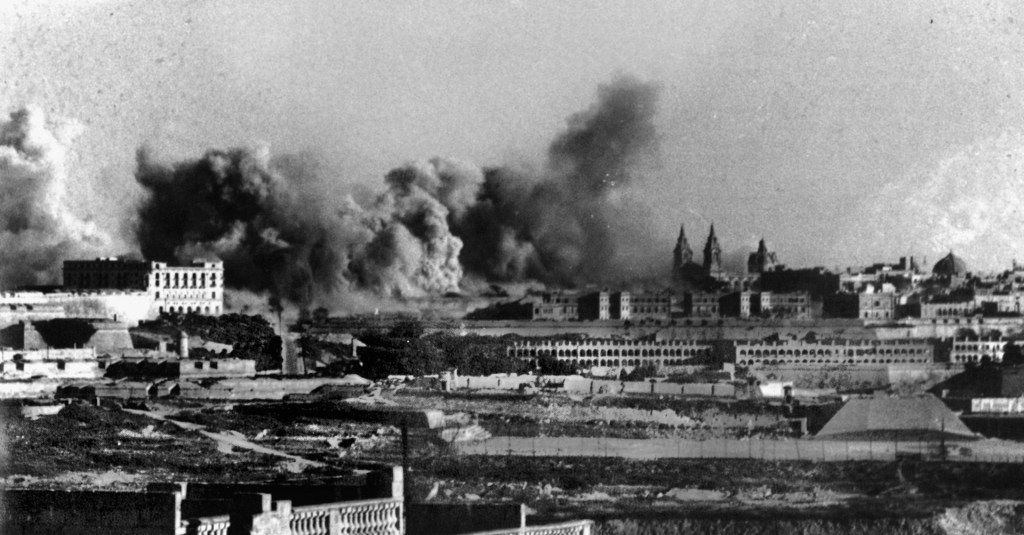
Simpson could hear the wail of a Stuka overheard as it dove on Lazaretto. The bomb crashed nearby, shaking the entire building. Simpson left the shelter and sprinted into Lazaretto to “assess the damage.” He found three Engine Room Artificers (ERAs) and another man on the mess deck who had not made it to the shelter. The windows had blown in. Glass littered the floor. Their unfinished breakfast was coated with fine power and dollops of rocks. The men appeared to be in shock, but seeing Simpson they pulled themselves together and made their down below to the shelter.
During a second raid at 2.30 PM, the Germans dropped parachute bombs on Manoel. These hit the western end of Lazaretto, causing the roofs of two entire stories, solidly built with limestone, to come down on the men’s quarters located in that part of the building. Eight other parachute bombs fell in other parts of Manoel. At Valletta, a bomb hit the Governor’s palace, prompting Dobbie and his staff to evacuate their offices to San Anton’s Palace in Verdala. Furious ack-ack fire brought down a Stuka, but German casualties were light in comparison to the damage they had wreaked. The raids had been uncontested by the RAF which was grounded. This enraged not only the submariners and Maltese civilians but also the Messerschmitt pilots of JG53, who “vented their rage” on a picket-boat south of Malta, tearing it to pieces in six passes.
Beak installed a quartet of anti-aircraft guns around Lazaretto to handle future attacks, but these could do little against continued massed raids which upset life at the submarine base. Only the arrival of Una on the 16th temporarily diverted Simpson from his immediate problems.
On entering the harbor, Una signaled that the first lieutenant was in charge as the skipper was ill. Unfazed, Simpson went down into the submarine to confront Martin.
He found Martin in a state of anxiety. Martin feebly argued that tanker he had sunk could not have been Lucania because it was being escorted by an aircraft and did not have the proper markings on the side.
Simpson, however, learned that Martin had fired his torpedoes at the tanker from an angle of 30 degrees — at which angle the markings would not have been visible. Martin’s continued arguments infuriated Simpson. “I suppose [Martin] was willing to believe anything he wished to believe,” Simpson says later. “I felt that I had been deliberately insulted and disobeyed; also the constant bombing was not helping my temper.”
Martin’s number one, Lt. L.F.L. “Rocky” Hill, came to his chief’s defense by arguing that Martin had never even seen the Admiralty order before sinking Lucania. Simpson was unamused.
Simpson immediately relieved Martin of command and sent him home to explain to the Admiralty why he had disobeyed orders. When it was reported that Tempest has been destroyed as an unintended victim of Una’s carelessness, Simpson’s rage became engorged. He hoped that Martin would be arraigned before Anthony Eden, the foreign secretary, who was known to be livid over the Lucania’s destruction. Command of the Una was handed to another officer, Lt. Pat Norman.
In England, a board of inquiry stripped Martin of frontline command. He would return to active duty in November 1942. But his first command was shore-based. He was given command of HMS Ultimatum during that submarine’s refit. He was next given command of the submarine Seadog, but discovered that the Admiralty had lost faith in him. When finally given command of a T-class submarine Tuna in 1943, Martin saw it as a chance for redemption. With Tuna, he sank U644 in April 1943, and claimed a second U-boat destroyed a month later. These acts would win him the DSO and reform his reputation.
Meanwhile, Malta was gradually vanishing under a carpet of bombs. The Admiralty dispatched a new convoy codenamed MF5 to resupply the island. German aircraft swarmed the convoy and every freighter was sunk. Its destruction exacerbated shortages of all kinds on the island. Stocks of torpedoes become so reduced that the submarines of the 10th Flotilla were reduced to two apiece.
On Sunday, 15 February 15, the Germans kept the island on alert for a record 19 hours and 59 minutes. A series of running battles developed. A German bomber penetrated the RAF’s meager fighter shield and bombed Kingsway, Valletta’s main road. Several bombs hit the Regent Cinema House where a packed house was watching a Gary Cooper melodrama. Scores died, but one sailor found himself trapped in the cinema’s bar. He sustained himself on drink until the rescue team pulls him from the wreckage three days later, “gloriously drunk.”

By nightfall on the 15th, Malta had only 11 operational Hurricanes left. The island’s new senior air controller, Group Captain Woody Woodhall, requested expert pilots from England. A group of men accordingly turned up a few days later. Among them was a ribald Canadian ace, Squadron Leader Stan Turner, Flight Lt. Laddie Lucas (a cultured Englishman and later a Member of Parliament) plus an affable Channel Islander, Flying Officer Raoul Daddo-Langlois (whose nickname was “Daddy-Longlegs”). But they were initially powerless to change matters. Fast running out of aircraft, the RAF was on the verge of collapse.
On 21 February, ten more pilots arrived on a Sunderland from Gibraltar. Among them was Squadron Leader Ron Chaffe who was set to take over 185 Squadron, Flight Lt. Keith Lawrence, an experienced, solemn-faced New Zealander who had two confirmed Me109 kills and Flight Lt. William “Bud” Connell, a Canadian. The others included, Flying Officers George Buchanan from Northern Rhodesia (now Zambia), Ronald “Ron” West and Robert McNair, a Canadian, Pilot Officer Richard “Sandy” McHan, a volunteer from one of the American “Eagle” Squadrons in England, and an Australian, Sgt. Gordon Tweedale.

Chaffe, 27, was a friendly man, with a large, balding pate and an easy smile. His career in the Royal Air Force was remarkable in that he had joined the RAF Voluntary Reserve as a common airman in January 1939 and had since worked his up in the ranks. Within a year of his enlistment, he had become a full trained pilot and a member of a combat squadron in Scotland, even though the squadron (No 245) saw little action during the Battle of Britain. Now, he was on Malta, the ultimate battleground for fighter pilots.
Flying Officer Robert “Buck” McNair, 23 years-old, had come recommended by Stanley Turner, who had known him in England while leading the Royal Canadian Air Force’s No 411 Squadron. That unit had been untested, undisciplined — and as events would prove, ineffective. A large number of aircraft and their pilots had been lost in accidents prompting the squadron diarist to write: “Our motto Inimicus Inimico (‘Hostile to an enemy’) — should more aptly be read ‘Hostile to Ourselves’.” By Mid-December 1941, when McNair had the chance to transfer to another unit overseas, his paltry score of one confirmed victory and two shared still constituted nearly half of the squadron’s overall tally.
McNair, although thin and slender, was the type of man who stood out in the room, a born leader of men, immensely self-confident and capable of inspiring others. On one occasion while in a line of men being decorated by King George VI, he was asked how he was feeling. “Just fine, sir,” he would tell the King. “How’s the Queen?”

Although only a high school graduate, he had good grades and was employed as a radio operator for the Saskatchewan Ministry of Natural Resources. When the war broke out, he successfully joined the Royal Canadian Air Force, graduating as a fighter pilot in March 1941.
The other “Buck” in the group was George “Buck” Buchanan, who at 30-years-old was a veritable “elder” among the young men. He also answered to the nickname “Zulu” owing to his birthplace, South Africa. An account suggested that Buchanan was an ex-policeman but that he was also an employee of the North Rhodesian timber industry. He is one of the influx’s most experienced pilots, having 262 hours of operational flying under his belt, although he has just one shared victory (a biplane Henschel Hs123 spotter plane) to his credit. His grading classified him a pilot of “average” ability. He was thought to be a plodder but the sort of stable pilot which makes up the bulk of any squadron. Of the other men, Flying Officer Ron West was a rookie, as was Gordon Tweedale, an Australian who is attached to 126 Squadron.
The new arrivals, like previous batches, were given a rude awakening when the Sunderland they had just arrived in, was strafed by an Me109s as it prepared for departure. Gunfire peppered the Sunderland’s wing and tail. The great seaplane keeled over, a total wreck. It sank two days later. The aircraft had been due to fly out several tour-expired pilots who were forced to wait for another Sunderland from Gibraltar. Meantime at Luqa, ground crews were in mourning for a valuable steamroller which had been wiped out and two fuel bowsers which had been damaged.
The next afternoon, the newly arrived Ron Chaffe was shot down on his first combat sortie while chasing a Ju88. Chaffe had committed the cardinal sin — he had failed to look over his shoulder to see the Messerschmitt behind him. Chaffe was spotted in his dinghy about five miles south of Delimara Point but no one was willing to go out and get him. The rescue launch refused to go because of Messerschmitts in the area and the Hurricanes are too busy fighting to provide cover for one of the Air-Rescue flying boats available. A proper search was made only that evening when the next senior officer in No 185, Flight Lt. Rhys Martin Lloyd (no relation to Hugh Lloyd), led a flight of four Hurricanes out to sea. The flight saw nothing in the gathering gloom.
Rhys Lloyd tried again after breakfast the following morning with nine Hurricanes and a Maryland in tow. Messerschmitts bounced them as they climbed, scattering the neat formation into a disorderly tangle. Just then, someone called a warning that two Ju88s and four Me109s were approaching from the southeast. Sgt. Garth Horricks fired on one of the Ju88s and saw a flurry of strikes on the German bomber. A moment later, an Me109 attacked Horricks, forcing him to break off.
Horricks turned on his attacker, blasting the German fighter at close-range. The Messerschmitt screamed out of the sky in flames. Rhys Lloyd shot a second Ju88, seeing strikes along the wing roots and fuselage. The bomber’s engine began to disgorge black smoke. The Ju88 crash-landed back at Catania. Chaffe was forgotten in the midst of all this. The search mission returned to base when the fighting petered out. When it refueled and went out again — it came up against more Messerschmitts from a following raid. A Ju88 plummeted towards the earth, its tail lopped off by anti-aircraft fire. One RAF pilot, Sonny Ormrod, observed several padres of a local church “on a neighboring roof taking an unholy delight in watching enemy airmen crashing to their deaths.”
A rescue launch was dispatched to collect airmen in the water. They found two Germans seriously injured and the body of a third. There was no sign of Chaffe or his dinghy. The Hurricanes suspended their search when more Me109s attacked. Out of frustration and anger, Sgt. Tony Boyd of 242 Squadron raked a Messerschmitt flown by Corporal Otto Butschek, knocking it into the sea while Sgt. Jock Gardiner of 126 Squadron damaged another Me109. Butschek bailed out but perished in the sea. This was a foreshadowing of Chaffe’s fate. No trace of him was ever found. His death turned his wife, Betty, into a premature widow and left Flight Lt. Rhys Lloyd temporarily in-command of 185 Squadron.
Meanwhile, Stan Turner had been monitoring the RAF’s situation with mounting concern. He came to the conclusion that three primary deficits were causing a majority of casualties on the island — a lack of Spitfires, the haphazard way in which a jumble of squadrons were scrambled, and poor air tactics.
Because Malta also had more pilots than planes, Turner asked Lloyd to create a pool of serviceable aircraft to be used by squadrons on alternate days. This method allowed squadron commanders the option of sending up at least two or three ready sections of aircraft, instead of having all squadrons send up scattered numbers of uncoordinated flights in piecemeal fashion.
Turner also waged a war against the RAF’s “Vic” formation but struggled to convince the battle-weary veterans of 249 Squadron that his way was the right way. “Look here,” he told “Laddie” Lucas who had assumed command of 249’s A Flight, “I shall look to you to help me with changing the flying pattern here. We can’t have any more of this goddam ‘Vic’ formations otherwise we’ll all get bumped, that’s for sure. I want you to learn this line-abreast stuff with me. And quickly.”
He began to trace on a dusty floor with his foot to show the merits of the “Finger four” flight formation and how it allowed each pilot to cover the tails of the others in the flight. “This way,” he said, “A couple of guys will never get bounced: attacked maybe, yes — but never surprised, no kidding.”
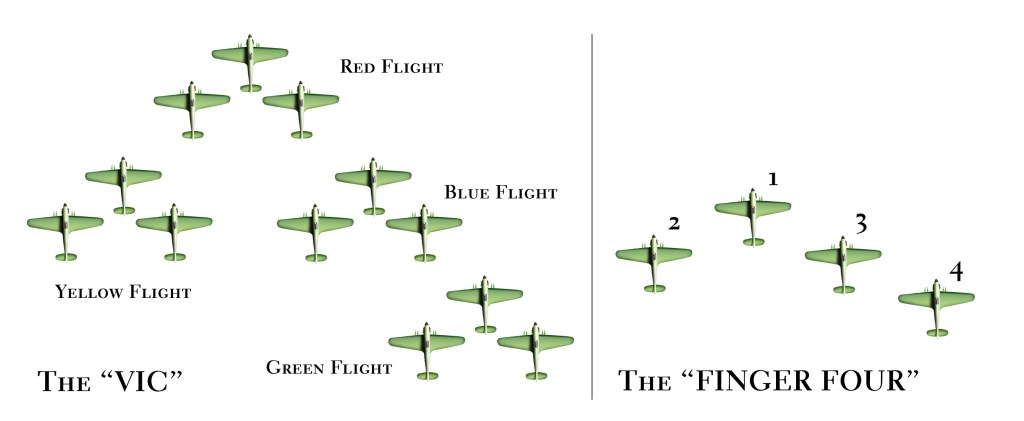
The third deficiency was rooted at Lascaris, over which he had no control. For one, he disagreed with existing practices vectoring Hurricanes straight into incoming enemy aircraft. Instead, he argued that aircraft should climb southwards, away from the raiders speeding in from the north, so that they had more time and space to freely gain altitude without having to mix it in with incoming enemy fighters. He also had an issue with carelessness among fighter controllers — a conclusion forged in a first-hand experience in the skies over the island on February 24, when he and with his American wingman, Pilot Officer Don Tedford, were vectored by ground control to a flight of four Me109 “bandits” allegedly dead ahead.
Turner radioed that he could not see the enemy. The controller insisted that the enemy was right in front of him. He was wrong. The four bandits were behind Turner. The two radar plots have been misidentified.
The Messerschmitts, from Stab (HQ)/JG53— formidable foes — hit them hard. Gunfire smashed into Turner’s engine and a bullet grazed his helmet but it was Tedford who took the brunt of the damage. He radioed that he had been wounded and was bailing out over the sea. He never made it. His victor, Lt. Franz Schiess, recorded his 16th confirmed kill of the war.
Tedford’s death aggreived all other American pilots on the island, chief of all the Los Angelino, Howard Coffin, who abandoned his post at Takali to mount a long search of the coastline on the off-chance that Tedford had survived. Turner was also nearly killed. He was unable to bail out because his cockpit canopy had jammed. Outside, flames ate away at his Hurricane. He dived to extinguish the flames and pranged the kite on Luqa. This did not help his mood.
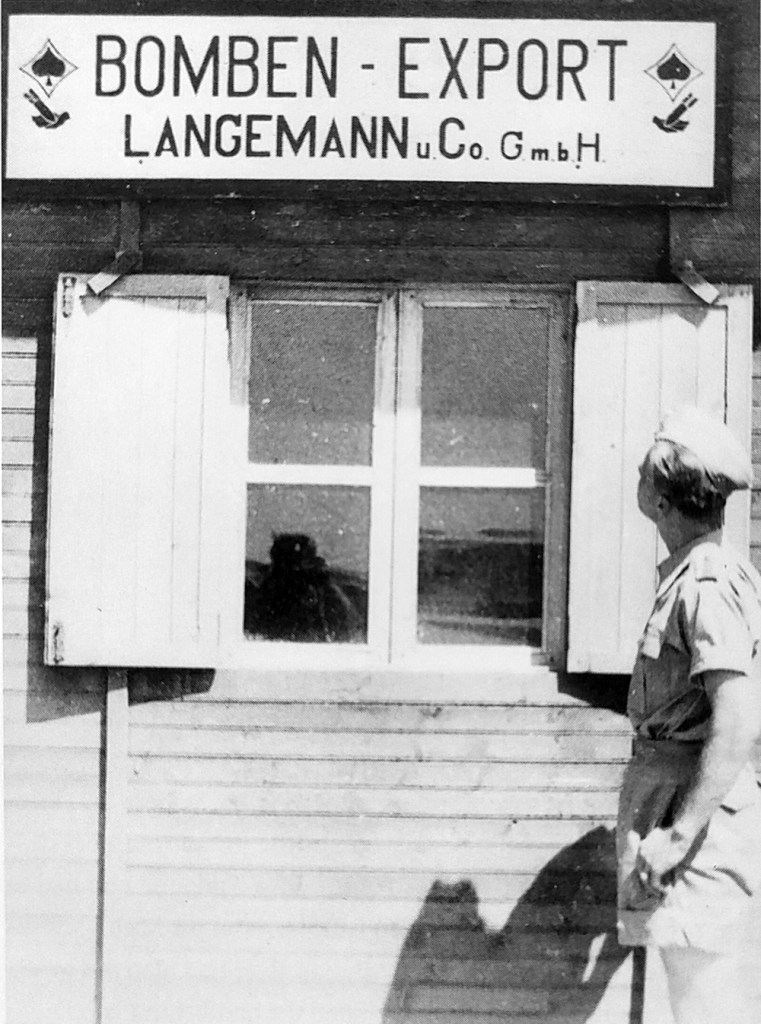
Fortuitous bad weather rolled in to give Malta a brief respite. A second batch of experienced pilots arrived as the RAF attempted to plug the holes. At Manoel island, battle fatigue was setting in. Simpson sent entire crews to a naval rest camp at Ghaijn Tuffieha in the northwestern part of the island. One submarine captain was so wound up, however, that he took to shooting at passing Messerschmitts with a rifle. Swift retribution materialized when the Germans strafed the rest camp.
At Manoel, there was no end to the raids. During a following raid on 27 February bombs fell on Lazaretto’s officers’ quarters, killing four men and injuring five. Among the dead were the skipper and three officers of the visiting Free Greek submarine, RHS Glaukos (Y6). The men, in the middle of a conference, had cavalierly chosen to disregard the air raid siren.
The Tenth Flotilla lost nearly all of its barracks in these raids. The bombs almost erased all the hard renovation work of the previous year — destroying Lazaretto’s sick bay, the cinema, the laundry and damaging mess decks. The roof of Simpson’s day cabin was blown to pieces, so he took to sleeping — as did some of his officers — in a large and derelict oil tank half-buried in rock. The tank had a floor space of 140 square feet. Planks are laid over patches of semi-coagulated oil but the stench of oil stuck to clothing, stubbornly following the men wherever they went. Soon the tank was an office. A chest of drawers and tables was installed. Officers became accustomed to seeing Simpson’s secretary, Miss Gomer, working diligently at her table as it were set on Fleet Street.
“I felt sure that the Axis intention was to destroy the submarines and the quarters of the crews as they were as much on Kesselring’s blacklist as the aerodromes,” Lloyd remarked later, with the benefit of hindsight.
Lloyd sent a message intended for Tedder and ultimately Sir Charles Portal, Chief of Staff of the Royal Air Force, in London: “Daylight attacks on aerodromes very serious. Little work being done owing to continuous alerts. Much minor damage to aircraft sufficient to make them unserviceable for night operations. They are repaired next day and then hit again. [Wellington] deliveries are a serious problem as they are damaged if they stay here during the day. The longer they stay, the more the damage. Have 17 Wellingtons in this category, including those damaged in landing on arrival here with further minor damage due to air action. To avoid this, the Wellingtons are passed through same night as arrival with relief crews. This is difficult with continuous intruder raids, but we can take it. Must have more fighters as soon as possible…Delay in Spitfires annoying.”
Lloyd was well aware that the island has only eight serviceable Hurricanes left by the month’s end. Abruptly, a rumor circulated on Friday, February 27, that Spitfires were enroute. Everyone was giddy with excitement but their enthusiasm died away at dusk. The old hands smiled knowingly. As always, London made promises it could not keep. But they were wrong. Spitfires were at Gibraltar, undergoing trials with experimental long-range fuel tanks, pending their transit to the island in the first week of March.
February died away with the island being witness of 235 alerts and 222 attacks. The island had been subject to 990 tons of bombs. When in January Fliegerkorps II had flown 1,741 sorties —these figures were up to 2,299 sorties in February (944 of which were fighter escort and 488 pure fighter patrols by JG53), with the Italians contributing 791 sorties.
The British noticed a pattern. Whereas in December and January, the attacks had been of the penny-packet variety, the raids had gained in numbers and intensity.
“At first the bombing was cautious,” said a British army intelligence officer on the island, Major R T Gilchrist. “Three Ju88s would come over three or four times a day, escorted by a large number of fighters. After a time…the raids increased to about eight a day and often five Ju88s were used. The targets were airfields and dispersal units and occasionally the dockyards. That the Germans still came in sections of only three to five was no longer due the weather but to Kesselring’s deliberate tactics of giving the enemy no rest. Whatever advantage this might have had, however, was dissipated by the fact that the defenses could concentrate its fire.”
The Italians made frantic plans for invasion. Lt-General Enno von Rintelen, the German army attaché to Comando Supreme, proposed employing large-scale German forces to invade at the end of Kesselring’s air offensive, while Rommel flies to Hitler’s headquarters in March to discuss future operations in North Africa and to ask that the island be seized.
Intended plan for Operation “C3/Herkules”
Phase 1 — Airborne landings with two divisions in the south of the island intended to capture Luqa, Hal Far & Kalafrana. After securing Luqa and Hal Far, German gliders to bring in additional troops and heavy equipment. Mdina and Qormi to be secured.
Phase 2 — 70,000-strong Italian forces to land at Marsaxlokk Bay with Italian armor, backed by special German unit equipped with ten captured Soviet KV tanks, plus Russian T-34s and German medium tanks. These units are to drive on Valletta.
Hitler did not see why Malta needed to be invaded at all. He stalled for time. To his naval chief, he declared: “I am a hero on land but a coward at sea.” In fact, Hitler had neither the stomach for an invasion nor the patience for a continued blockade which required that large naval and air forces be retained on Sicily. He decreed that the invasion, codenamed Herkules (because it was such a Herculean task) should only take place during the next full-moon period in June, which would give him enough time to add another postponement if necessary.
He also declared that air “attacks alone would prevent the enemy from building Malta’s offensive and defensive capacity.” Kesselring extolled his men to intensify the bombing and bring the British to their knees.
While this happened, Britain was preparing to deliver the first batch of Supermarine Spitfire Mk VB fighters to Malta from the old fleet carrier, HMS Eagle. Onboard the Eagle were a hundred mechanics and 16 crated tropicalized Spitfire Mark VBs. Each “Spit” each with had a large Vokes air filter in the nose which gave the elegant Spitfires a dropping, clown-like chin and cut down on their maximum speed.
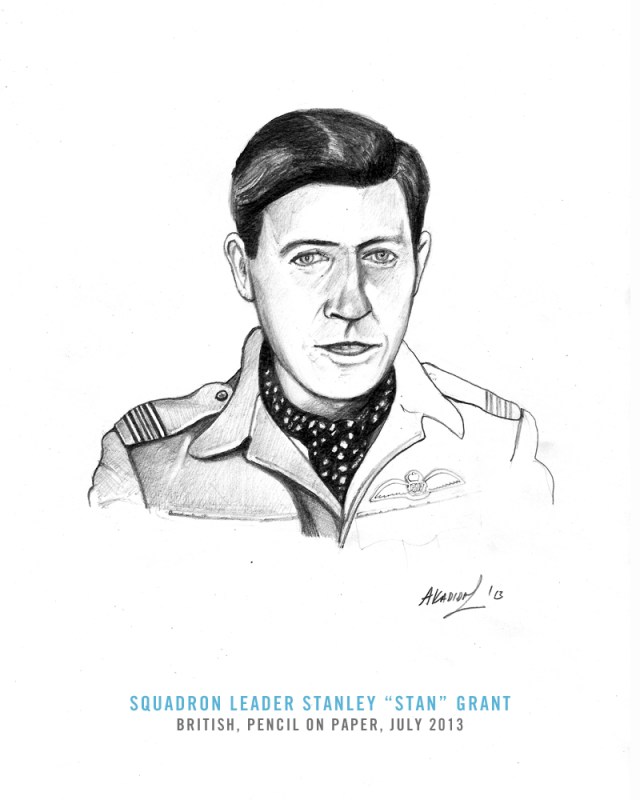
The pilot group was under the command of Squadron Leader Stanley “Stan” Grant, an Englishman possessed of the hardy, sinuous good-looks of an American Midwesterner. Grant was a 1938 graduate of the illustrious RAF College at Cranwell.
He had seen action over Dunkirk and the Battle of Britain with 65 Squadron, but had just one conclusive victory, a twin-engined Me110, to his credit.
The other pilots in the group were: Sgt. Ray Hesselyn from New Zealand, Flight Lt. Philip Heppell, Sgts. Ferraby, Ian MacCormack, John Tayleur, John “Slim” Yarra of Australia, H.J. Fox and Irving Gass, Pilot Officers Ken Murray, Bob Sim and Jim Guerin, Douglas Leggo from Rhodesia (now Zimbabwe) and a Greek national from Rhodesia, Ioannis “Johnny” Plagis. Half of this group was destined to become aces. The most experienced among them was “Nip” Heppell who hailed from a family of fliers. His father had been an pilot in the Royal Flying Corps (RFC) of the last great war and his sister was in training to become a pilot for RAF Ferry Command.
Several of the pilots were outright rookies like Sgt. Hesselyn and Johnny Plagis, the latter having failed to join the Rhodesian Air Force because he was not a citizen of that colony. Plagis was graded as “above average” during training. Since then, he had been serving with the RAF’s 266 (Rhodesia) Squadron until orders came through telling him to go to the Middle East.
At Gibraltar, Gass and Fox were replaced by Flight Lt. Norman MacQueen and Flying Officer Norman Lee. The 22 year-old “Mac” MacQueen from Rhyl, North Wales was immensely likeable and got along with officers and NCO alike because of his humble origins — He had joined the RAF seven days after the start of the war on 10 September 1940 as an Aircraftsman (the lowest rank in the air force). His subsequent rise through the ranks was meteoric. By October 1940, he was a sergeant. A month later he was commissioned as an officer. Although he had been in action from late 1940, he had just a single damaged Me109F to his credit. He, like Plagis, had been ordered out into the Mediterranean.
Upon the carrier group’s entry at Gibraltar on 22 February, British handlers unloaded the crates at night (to conceal the operation from a German observation station over the Spanish border). Then began the work to assemble the fighters within a large warehouse. Half-finished with wings fitted and undercarriages lowered, the aircraft were loaded onto Eagle on the night of 22 February.
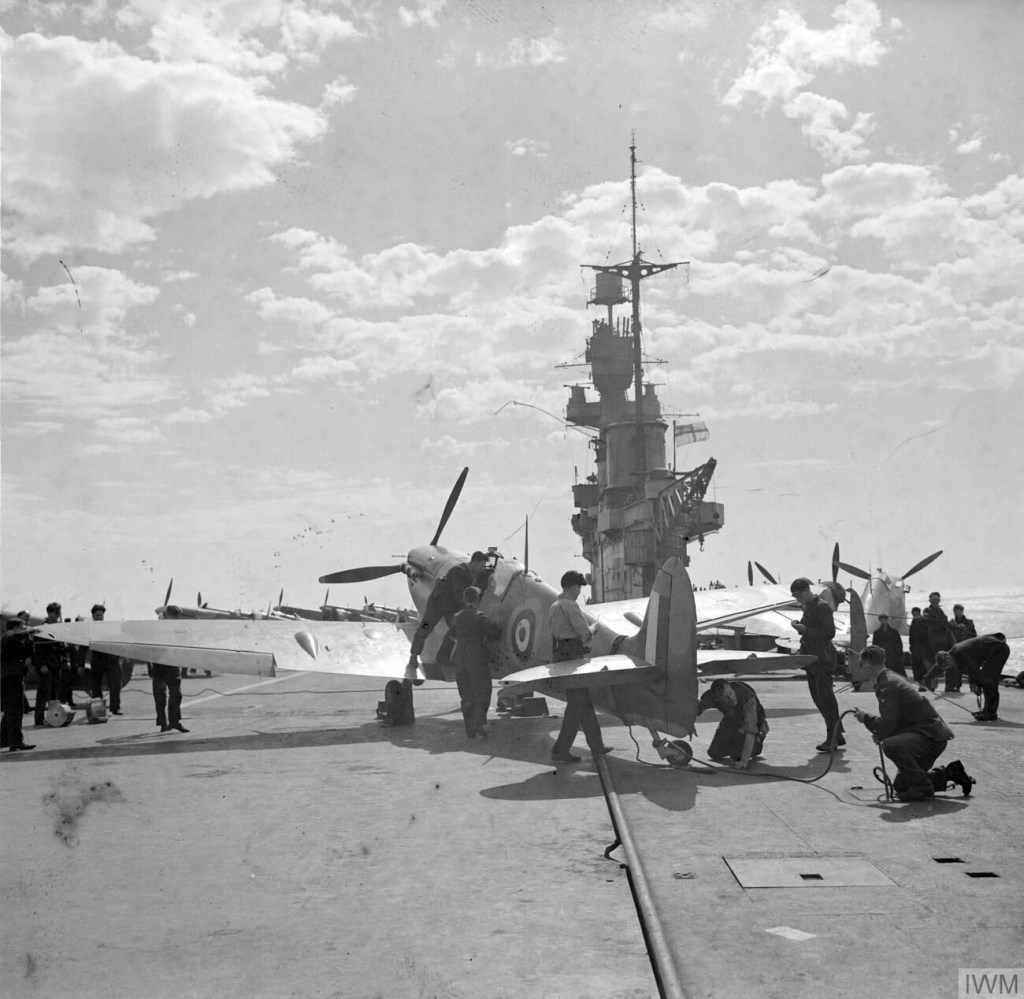
Four days later, on the night of February 26, the carrier sailed, accompanied by the Argus and Vice-Admiral Sir Edward Neville Syfret’s Force H. This comprised the battleships Malaya, the cruiser Hermione and nine destroyers.
When the Spitfires were readied for flight on the following day, the chief engineering officer discovered that the Spitfires’ slipper fuel tanks had been connected in such a way that fuel was being siphoned off into the airstream instead of going into the engine. The fleet turned back for Gibraltar so that a specialist could be flown in to fix the problem. Five days later, on 5 March, the British tried again. All throughout this second journey, the pilots worried that their Spitfires would not make the long journey to Malta.
The fateful moment came at 7 AM on the 7th when Eagle arrived at a point some 600 miles west of Malta. The carrier turned into the wind to allow the Spitfires to fly off. The first Spitfire “Club Run,” Operation Spotter I, had begun.
Pilots were given their orders, headings and the approximate distances to the island. Most worried that their fighters were grossly overloaded by the slipper tanks and would fail to take off from the carrier considering that she had only 667 feet of runway. “When the time came…everyone was keyed up and expectant and most of us wondered if the Spitfire would really get off the deck,” Sgt. Yarra said.
Eight Bristol Blenheims from 1442 Flight in Gibraltar, each dispatched at half-hour intervals, arrived over the carrier to lead the fighters to Malta.
“All the aircraft were lined up waiting and everyone was in their cockpits half an hour before the first Blenheim, which was to lead us, arrived,” Yarra said.
To give every pilot the fair chance of a successful takeoff, the overweight Spitfires were to wait with flaps down until the carrier rose on a wave. At this moment, the deck officer was to signal them off. The Spitfires did not have half-flaps, so a block of wood was wedged into flaps to give them a flap angle of 15 degrees. Once in flight, the flaps were to be lowered once which allow the blocks to fall away.
The slender, taut, Stanley Grant was the first off, followed by the others at 14 pre-arranged intervals. To Yarra’s consternation he discovered that his Spitfire (AB333) had a mechanical fault. He was obliged to return to Gibraltar in the Eagle.

Once airborne, the formation of Spitfires headed towards Malta. Approaching the island two hours later, they found a reception committee of Hurricanes. The Spitfires began to rapidly descend on Takali. The landing gear of Hesselyn’s Spitfire would not lower. He conducted a belly landing. When the smoke, the dust and the whirlwind of thoughts died down, the arrivals found that they were unimpressed by their new home. “Malta — the land of burnt-out Wimpeys and bowsers,” Plagis said.
The arrival of the Spitfires gave the RAF a much-needed shot in the arm. They were the first “Spits” to be based outside England. Of the three primary fighters in action over Malta, the Me109F had the advantage of speed and the MC202 had the advantage of rate of climb. The Spitfire, however, had the advantage of maneuverability, although its large Vokes air filters hobbled its rate of climb and speed. It was also heavily armored and had a strengthened main gear leg to be able to operate on Malta’s rough airfields. Even when most of the island-based Spitfires had two of their four 20mm Hispano cannons removed to reduce weight and conserve stocks of ammunition, the aircraft remained the most potently armed of the trio.
The Spitfires went into No 249 Squadron and Grant joined the unit as a supernumerary squadron commander. The infusion of pilots and aircraft resuscitated the squadron which had been languishing for lack of aircraft. Its roster now comprised 29 Spitfire-trained pilots. Most of the squadron’s Hurricane pilots were shunted to No 126 Squadron.
Four, radar-equipped and night fighting Bristol Beaufighters, which had also flown in at the tail-end of the formation, joined 1435 Flight. They gradually weaned off the unit’s Hurricanes which were ill-suited for night combat. Like the Spitfires, they were first of their kind outside Britain.
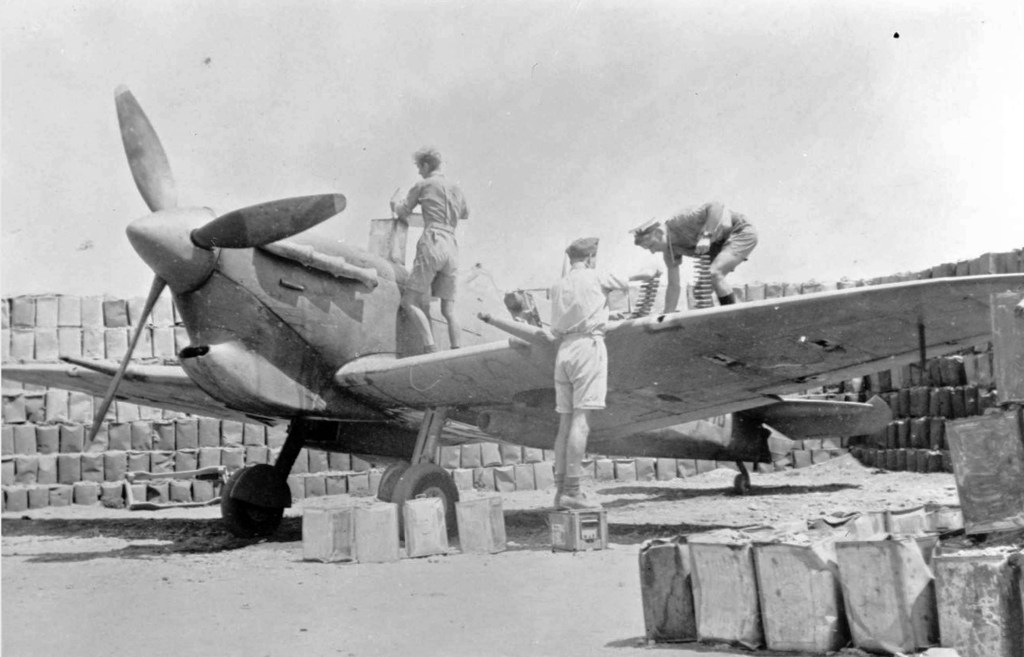
Ground crews were frantic in their attempts to get the Spitfires ready, running them through endless equipment checks and repainting their grey-green paint jobs which were more suited for Europe, with dark earth brown and middle sand or dark sea grey. While this happened, the Luftwaffe arrived in strength over the island on 9 March. The island’s serviceable Hurricanes, just 10, rose in challenge.
A Me109 fired at a Hurricane flown by Sgt. Colin Finlay. Rounds peppered the Hurricane’s elevator and blew off half of the rudder, gutting the wings and fuselage, leaving the fabric shredded with great, gaping holes through which the sinuous innards — wires, control struts and levers — could be seen.
Like a gutted, brutalized animal, the Hurricane and its pilot bolted from the scene. Finlay set the aircraft down at Takali.
Twenty minutes into noon, eighteen Ju88s from KG54 with twenty-six Me109s from III/JG53, trundled upon Luqa, Safi and Hal Far. They were met in the lawless skies by 14 Hurricanes peddling the only currency which was skill. Sgt. Archie Steele of 185 Squadron raced through the German formation, shooting at anything that crossed his path. A Me109 was fatally stricken. A Ju88 was damaged but continued flying. Another Me109 was hit but showed no outwards signs of having been damaged. A second Hurricane, flown by Sgt. Gordon Tweedale, got on the tail of a Ju88 which had just dropped its bombs. Tweedale opened up with all his guns. Eight streams of gunfire converged into a cone which ripped through the Ju88. Three Messerschmitts were drawn by the firing.

Gentle-looking, with large, quick eyes, a long chin and a faint trace of a flaxen, trimmed moustache breaking up his youthful, 24-year-old features, Tweedale was risking much by serving on Malta. He was his family’s sole breadwinner. For years since turning 15, he had supported his mother and 13-year-old brother, Graham, working lowly jobs as a clerk, as a jackeroo and as a stockman. He had eschewed a formal education to help put food on the table. But his attempts to join the Royal Air Australian Air Force had come to naught in September 1939 when his lowly educational qualifications had counted against him. He had then done what Beurling had done — obtained a private pilot’s license and improved his mathematical and navigation skills. His diligence had paid off. By July 1940, he was in flight training. Yet, his mother worried about him. After all he was a sensitive soul who despite his hard-life as a cattle-hand, played the violin, composed poetry and built model ships. But Tweedale’s mettle was hard. After all, he had volunteered to come to Malta which he described in a letter home as “the hottest place this side of hell.”
Bullets and cannon rounds tore into his Hurricane and something metal smashed into his left heel. Bleeding and in pain, Tweedale dove for the deck, his kite in bad shape with pieces falling off. He belly-landed at Takali. One Me109 followed him down, intent on killing him. The German flashed across a Hurricane being flown by Sgt. Steele who was touching down on the runway at the same time. Steele instantly opened fire. A lethal cloud of lead entered the world with the sound of ripping canvas and blazed past the Messerschmitt. The alarmed German peeled off and raced along the airfield, chased by a raking stream of anti-aircraft fire.
Despite the heroics of the Hurricane pilots, only one Ju88 had been destroyed. In return, the Luftwaffe claimed four Hurricanes shot down — when in reality none had been destroyed — although those flown by Tweedale and Pilot Officer Howard Coffin had crash-landed. Tweedale spent the next three weeks in a hospital, missing much of the carnage which would decimate his squadron in that period.
During a third raid later that day, there were no more serviceable Hurricanes to send up and so the ack-ack held the line. The anti-aircraft fire ravaged a Ju88 flown by staffelkapitän Lt. Gerhard Becker of 6/KG77. Becker and two of his crew bailed out. Flying Officer Philp “Wiggles” Wigley watched the Ju88 tear into the earth south of the airfield. Moments, later two of the bailed out German crewmen landed hundred yards away, followed by an MG13 machinegun complete with its circular, bulletproof glass screen which thudded into the ground between them. Both Germans were unconscious.
“They were taken to the Station sick quarters before they would become victims of the unfriendly intentions of local people,” Wigley said.
Incidents of Maltese atrocities upon bailed out Axis aircrews were on the rise. Howard Coffin wrote about an incident during which a German pilot had landed in his parachute only to have Maltese “swarm over him with shovels and rakes and hoes and knives. I heard one sharp cry and then the voices roared louder than ever. They cut off his head and spiked it on the gatepost of a ruined house in Mosta. I saw it when I went over days later to catch a bus to Valletta. There were three dogs sitting on their haunches and howling up at the head. I felt a bit sickened but I paused a moment to study the man’s face. Death, I suppose, strips away all corruption of thought that activates such a man. His features seemed, in death, somewhat the same as ours. It was a young face, rather woeful.”

Incredibly, despite their daily attacks on Malta, the Italians and Germans did not discover that Spitfires had arrived on the island – until 10 March. On that day, to their shock, Messerschmitt pilots found themselves besieged by seven of the new machines.
News of the Spitfires sent ripples of shock within Fliegerkorps II. The Germans rapidly reevaluated their tactics, calling for the Spitfire base at Takali to be obliterated using the maximum firepower of the Korps. Once Takali was knocked out, German bombers were to systematically reduce the island’s two remaining airfields at Hal Far and Luqa, followed by the wholesale bombing of dock installations in Grand Harbor. The attacks were scheduled to start on 20 March.
Meantime, back in England, George Beurling was posted to a Canadian fighter squadron. He found this ironic considering that the Royal Canadian Air Force had wanted nothing to do with him previously. A greater shock transpired when, on his first combat sweep over France in March, he was nearly shot down and killed by a German squadron under that erstwhile Malta ace, Lt. Joachim Münchberg (now back in Europe). Upon his return to the airfield, he discovered that Allied losses had been severe and that the skipper of the other Canadian squadron on the airfield was dead. As much as he was jarred by this first encounter with the enemy, he vowed never to be caught off-guard again.
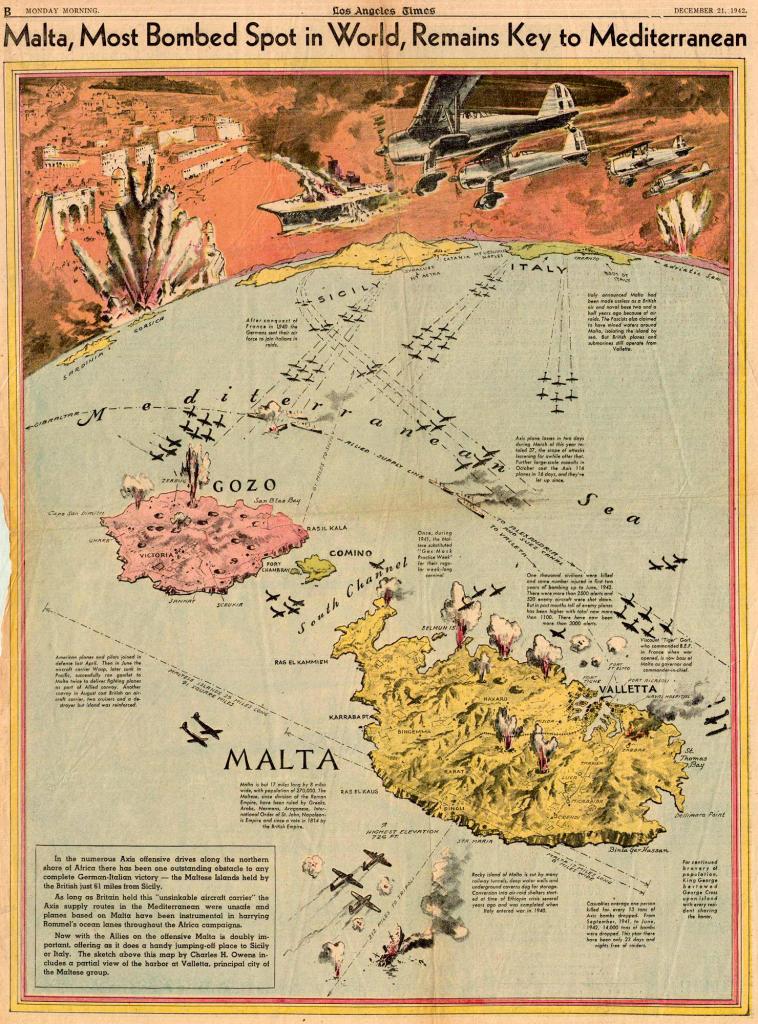
Despite the exigencies of supplies for the battles raging in North Africa, the British Admiralty piled 30,000 tons of supplies on four cargo ships for Malta. Designated convoy MW10, the freighters bristled with anti-aircraft guns and sailed on March 20, flanked by a massive escort. Malta, meantime, was a conflagration. Valletta and the three cities area streamed black smoke as the Germans pummeled the area with rocket-powered bombs. Takali took the brunt.
A sprawl of 106 Ju88s and over 60 Me109s thundered over the island between 7 AM and 10.15 AM on 20 March. Bombs pummeled Valletta, Sliema, St. Julian’s, Hamrun, Zeitjun, Manoel Island, Grand Harbor and most important of all, Takali. The airfield was hit but several of its Spitfires and Hurricanes are airborne at the time and thus escaped immediate destruction.
Flying Officer Buck McNair shot at a Me109 as it turned. He saw pieces fall off. The Messerschmitt dove towards the sea, spewing white smoke before ending in a distant splash south of Delimara Point. McNair was exultant but nearby, Pilot Officer Doug Leggo, the Rhodesian, was in trouble.
Having spent the night drunk and with a woman, Leggo was in no shape for operations. Johnny Plagis had urged him not to fly that morning, but Leggo would have none of it. Once airborne, however, he had trouble keeping up with the rest of the flight.
All of this was noticed by a German pilot, Lt. Hermann Neuhoff, who dove from out of the sun, blasting Leggo’s Spitfire with concentrated, direct fire. The Spitfire lurched and wobbled, ejecting thick, black smoke that hung like a pall in the sky. The Spitfire went into a dive. Leggo tumbled out of doomed machine as it crossed the 22,000 ft mark and opened his chute. The island appeared like a postage stamp below him. A German fighter came roaring out the sky and either fired at the parachute or caused its collapse with its slipstream. Leggo plummeted to his death — to the horror of his squadron mates. A distraught Plagis blamed himself. “I swear to shoot down ten for Doug — I will too, if it takes me a lifetime,” he declared.
Two Ju88s bombard Valletta with PC1800 rocket-assisted bombs. One fireball was seen to smash into the now-vacated Governor’s Palace. Despite the intensity of the morning attack, casualties were unusually low — six civilians and two soldiers killed and forty-one people injured. But by far, the worst was due to come that evening when large readings appeared on Malta’s radar screens at 6.30 PM. At the fore were 63 Ju88s from nearly every bomber unit within Fliegerkorps II. They were escorted by Ju88C nightfighters and Me109s — all rumbling straight for Takali.
Not a single RAF fighter rose in challenge. The Germans roared over the airfield with impunity, shrugging off the ack-ack and blasting the landscape with heavy bombs. Fire and explosives tore through the airfield’s workshops and hangers with the bombers paying particular attention to the Mdina ramparts where Germans believe the British had underground hangers. Air reconnaissance photos had revealed a ramp at the perimeter of the airfield with a large pile of rock and earth outside. What else could it be but a subterranean hanger? The idea was not implausible. The Italians had similar underground spaces on Pantelleria.
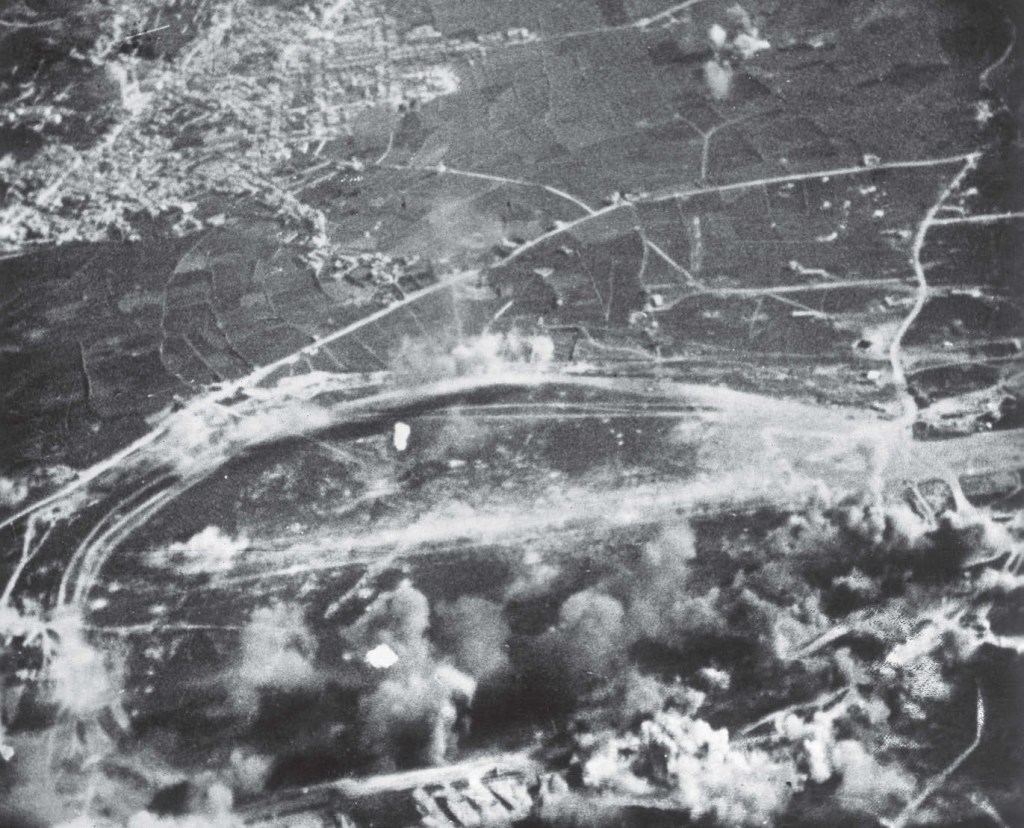
The Ju88s dive-bombed the ramparts, dropping more PC1800 rocket-assisted bombs which were designed to penetrate 45-feet of rock. Other bombers hurled incendiary bombs onto the ramp to set the fighters within ablaze. The attack contained a measure of accuracy — except there were no underground hangers.
There was, however, little to be happy about state of Takali after the attack. Pummeled by 114 tons of bombs, the airfield was gouged and scarred and indistinguishable from a moonscape. The runway and above-ground hangers were in shambles. The anti-aircraft gunners had claimed the destruction of four Ju88s. In actuality, they had achieved the crashing of a single, bent Ju88 at Catania.
When the Germans returned on the 21st they find that not a single British fighter would take off to stop them. They took this as proof that the bombing of the “underground hangers” had been a success. Bombers from Kampfgruppen 606 and 806, I/KG54, KG77 carpet-bombed Takali, unloading 182 tons of bombs on the airfield, searing the landscape but incredibly, killing just two people and injuring seven others. This was a testament to the protectiveness of Malta’s limestone shelters.

As the bombers turned for home, eight Me110 heavy fighters from III/ZG26 materialized out of thin air and roared over Hal Far, thrashing the landscape with heavy cannon and machinegun fire. The gunfire plunged into two Hurricanes, a Spitfire and two Beauforts. Belatedly, six Hurricanes from 185 Squadron scrambled. They were led by their new skipper, Squadron Leader E.B. Mortimer-Rose.
The British were out for blood. They hammered the Me110s, claiming every single one as shot down despite the intervention of 35 Me109s. What is known for certain is that the Germans lost at least one Me110 and perhaps two more.
As the Me110s are being hammered, Eagle executed another club run, flying off 16 Spitfires of towards Malta. The operation was codenamed Picket I. The force was led by a redoubtable Battle of Britain ace, Squadron Leader Edward “Jumbo” Gracie DFC, a gruff and bulbous commander reputed to have joined the air force so that he could do his fighting sitting down.
He flight commander in 56 Squadron throughout the Battle of Britain shooting down four German aircraft by 1 August 1940 and claimed a further three by August 30 when he crash-landed following combat and nearly broke his neck. During Picket I, the pilots under his command were an average bunch. Several, however, were destined to make a name for themselves on the island, including Flight Lt. Hugh A.S. “Tim” Johnston, Pilot Officer Jimmy Peck (an American) and Slim Yarra, who was anxious to rejoin his mates from Spotter I.
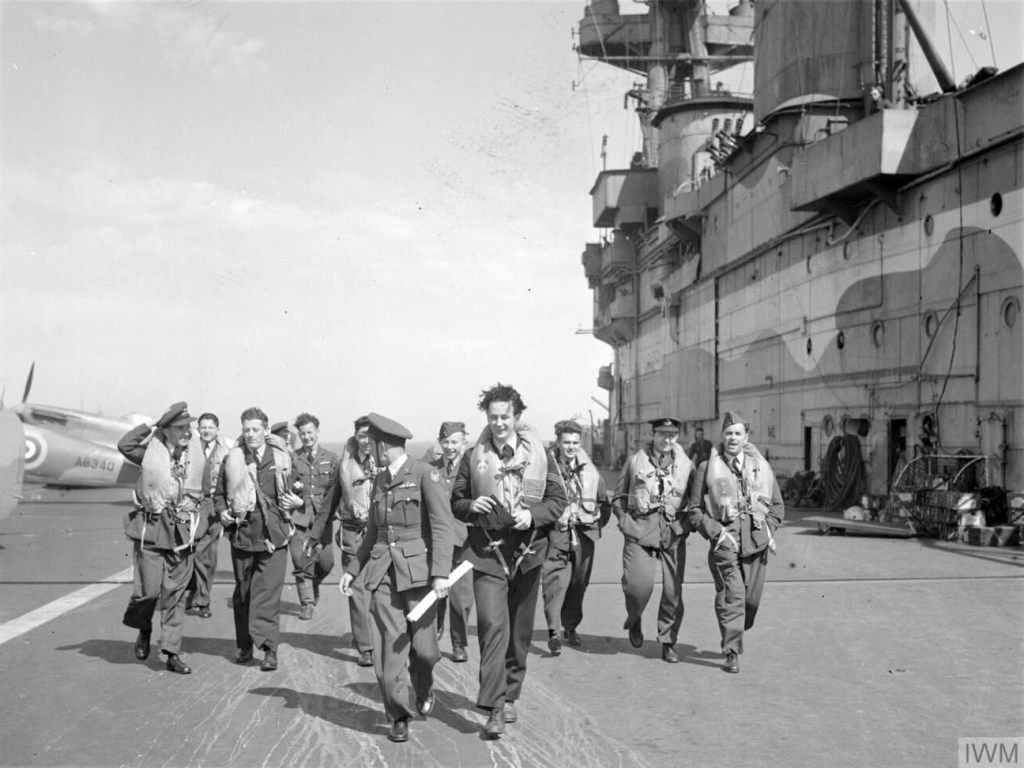
The bad weather prevented additional Blenheim guides from rendezvousing with the carrier, forcing the launch of just the first batch of nine Spitfires. As the flight passed Pantelleria, they spotted a squadron of Italian CR42 Falcos which, to the surprise of the British, made no attempt to attack. Malta heaved into sight four hours later. The Spitfires entered the landing circuit over Takali. Flight Lt. Tim Johnston was cleared to land. Carefully scrutinizing the sky around him, Johnston dropped his wheels when he noticed two aircraft above and behind him. Deciding that they are Hurricanes, he remained in the circuit until red tracers flashed past his cockpit.
Johnston instantly retracted his landing gear and pulled the Spitfire into a hard turn so violent that he almost stalled. At that second, a pair of fast-moving aircraft zoomed overhead in a blur and disappeared. Once on the ground, a shaken Johnston was told by other pilots and ground-crews that the two machines were Me109s and that they had fired a “quick, wild burst” at him.
Slim Yarra, who had also landed, was anxious to meet his old friends from Spotter. He was aghast to learn that only two Spitfires still survived out of that original batch of 15 that had arrived just a few weeks ago. Four men whom he knew as alive, full of laughter and spirit, had been killed — Cormack, Fox, Leggo and Murray. In fact, a fifth man, Jim Guerin, would die scant minutes later.
The new Spitfires had also arrived just in time to watch a massive German raid hit Takali at 2.35 in the afternoon. Seventy Ju88s, covered by a large force of Messerschmitts, smothered the airfield and the surrounding towns of Rabat and Mosta with bombs. Miraculously, only a few aircraft are damaged, but bombing smashes the surrounding towns (excluding Mdina) and killed 64 people mostly at Mosta and Rabat.
A bomb exploded outside the front door of the Point de Vue Hotel in Rabat, which had been requisitioned as a billet for officers based at Takali.
A number of RAF officers were in the lobby when an enormous, white blast obliterated their world. Four pilots were killed instantly, including Flight Lt. Cecil Baker and Pilot Officer Hollis Hallet of 126 Squadron and Flying Officer John Booth and Guerin of 249 Squadron. A 14-year old Maltese schoolboy, Leon Gamblin, who stumbled upon the scene, was horrified to see a decapitated body.
Three pilots had various degrees of wounds. Flying Officer Buck McNair was hurled nearly thirty feet upstairs by the force of the blast which forced his left arm out of its joint. When his ears stopped ringing, McNair realized what had happened.
“I heard a moan, so I put my hand gently on the bodies to feel which of them was alive,” he said. “One of them had a hole more than a foot-wide, right through the abdomen; Another’s head was split wide open into two halves, from back to front, by a piece of shrapnel. The face had expanded to twice its size. How the man was still alive I don’t know. I thought of shooting him with my revolver. As I felt for it, I heard [Flight Lt.] Bud Connell’s voice behind me: ‘Look at this mess!’”
McNair rested a hand on a wall to steady himself. His hand slithered down. The wall looked dry because it was covered with dust but was coated with blood underneath with “bits of meat stuck to it — like at the butcher’s when they’re chopping up meat and cleaning up a joint.” He turned to Connell and said: “For God’s sake, don’t come in here.” Then McNair noticed his own battledress and trousers hanging in ribbons. He helped one of the wounded to a stretcher but could not recognize the man for his mangled face. “I put a cloth over his face and then a stupid orderly took it off. It was the most horrible sight I’ve ever seen and I’ve seen chappies with heads off and gaping wounds and horrible burns…”
Another survivor, Flying Officer Ron West stood muted in shock. An ambulance pulled up in front of the ruined hotel. A doctor, seeing McNair in relative good shape, asked him to help with the bodies. “Get someone else,” McNair snapped. “I’ve seen enough.”
“As we discussed [the bombing] we began to understand the awfulness of it all. Then we started cursing the bloody Huns — it was maddening to think that all we could do was curse. We were inwardly sick, sick at heart.”
Flying Officer “Buck” McNair
Takali continued to take a pounding. By the evening of the 21st, returning German aircrews reported that it resembled the center of a “volcanic explosion.”

What a slaughter of human lives… Hospitals bombed, churches and town after town cleared out….Unless help comes soon, God save us. No food, cigarette, fuel.
Pilot Officer Howard Coffin
The bombing shattered the Valletta water reservoir situated at the edge of the airfield, flooding Takali and helping to bring some of the fires under control — but at tremendous cost. Freshwater became short in supply until the summer rains could arrive. Lloyd was appalled by the damage at Takali.
He remarked that the airfield reminded him of a World War I battlefield and feared that it would be knocked out for a week. Amid the battered airfield were the ruins of four Hurricanes, two Spitfires, a Beaufighter, a Maryland and a Wellington. Another five Spitfires, 15 Hurricanes, three Beaufighters and a Maryland had been damaged. Homes in the towns and villages surrounding the airfield had suffered terribly. At Mosta, some 35 houses have been destroyed and 31 civilians were dead and 80 injured. At Sliema, 19 homes were damaged and two people killed.
Between 20-21 March, 295 tons of bombs fell on Takali — making it the most heavily bombed airfield in the history of warfare. A bomb also hit the St. Agatha Covent at Rabat where several Maltese fascists and stalwart members of Mizzi’s nationalist party were held. Two prisoners died.
Just when it seemed that the Luftwaffe would blast the RAF from existence, the action moved away from Takali and centered on the incoming ships of convoy MW10. Just when the RAF thought it had no leg to stand on, it found that it had been given a reprieve. The convoy took their place of their suffering, taking the brunt of Axis energy and firepower, and in doing so, produced a fracas destined to enter naval lore known as the Second Battle of Sirte.
The incoming ships of the convoy MW10 had already spurred the Italian fleet into action. The Italian fleet commander, Admiral Angelo Iachino, believed he had the element of surprise. Unbeknownst to him, he had been spotted by a Malta-based submarine in the early morning hours of 22 March.
As the opposing fleets made contact that afternoon, a long-range duel developed. But a violent storm was gathering momentum. By 9 PM, massive waves threatened to swallow the combatants. At least two Italian destroyers sank in the storm before the battle petered out.
By nightfall on the 22nd, convoy MW10 was still 240 miles from Malta. The fastest ship in the convoy, Breconshire, raced ahead and was off Malta by daybreak.
The Breconshire was already a household name on Malta, having made seven previous supply runs to the island since April 1941. Instead of rushing into the harbor, she waited for the rest of the convoy to catch up. This was a mistake. Hit repeatedly by German aircraft, she was crippled while the rest of the convoy sustained losses. One freighter was sunk outright, and the remaining two were damaged. The surviving freighters berthed at Grand Harbor. They were repeatedly bombed even as Lloyd scraped together a force of 14 Spitfires and 11 Hurricanes to protect them. By 26 March, the ships were on fire and sinking.

Albert Toft, the skipper of one of the convoy ships, the SS Talabot, witnessed the bombardment of his ship from the safety of a shelter ashore. When the attack ended, he made his way way back on board to see that a bomb had gone through the electrician’s cabin and through the main deck before exploding in the engine room and starting a fire there. Another bomb had exploded near hold No. 1, where barrels of benzene have been stored. Uncontrolled, the flames crept towards Holds 3 and 4, where aviation bombs and torpedoes were kept.
Toft called on the captain of a nearby cruiser to blast a hole below the waterline to flood the engine room and extinguish the flames. The cruiser’s captain responded that he did not have the authorization to do so. The matter was forward to Vice-Admiral Leatham who sent word that he also could order the cruiser to fire on the ship. However, he gave Toft full permission to scuttle the ship.
Lt. Denis Copperwheat, an officer from a British cruiser, Penelope, volunteered to place the scuttling charges.

However, fearing that the ship’s volatile stores would go up at any moment, residents of the dock-front at Floriana began evacuating from their homes and offices. The heat from the burning ships mingled with the spring heat. At sunset, the sky over Floriana turned a dark, uneasy red.
All the surrounding areas in the Grand Harbor assume a reddish incandescence: the skies are red, the sea is red; red prevails everywhere – such a scene has never been witnessed before… Floriana looks like a furnace.
Local resident
As Toft and his crew engaged in a last minute search of their quarters to save personal belongings and artifacts, the fire reached Hold No. 1. At that moment, a gang of sailors appeared with scuttling charges . Copperwheat went to work. Toft and his crew hastily disembarked. The deck was so hot that “it sputtered under the soles of my shoes,” Toft remarked. The last off the ship was the stewardess, Margit Johnsen of Ålesund, Norway. She held the ship’s cat.
Johnsen, a survivor of the sinking of MV Tudor on 19 June 1940, impressed the men on Malta with her calm — so much so that she is awarded three medals, the War Medal, the St. Olav medal with Oak Branch and the Distinguished Service Cross of Malta — and a nickname: “Malta-Margit.” A photograph would later show her slender-necked and tall, her frizzled blonde hair blowing in the wind, standing somewhat perturbed on the deck of a ship, surrounded by both austere and admiring naval men as a commodore pinned the three medals on her blouse.
After everyone was ashore, Copperwheat detonated the charges. The Talabot went up in a series of sharp, loud explosions that rang across the dockyard. As her ruined remains settled in the shallows, her crew and her naval liaison officers were reminded that just 972 out of her total cargo of 8,956 tons had been unloaded. With her gunwale showing above the waterline, she burned for the next two days, blackening the sky over Grand Harbor. Later, Copperwheat, in a diver’s suit, would cut open several holes on her side to help other divers remove several crates of munitions, including 16 torpedoes. For his work, he would win the George Cross.
An inquest later discovered that in the two days during which they were afloat at port, Maltese dockworkers, who resenting being used as expendable labor by the British, had refused to work extended hours. Only 20% of the convoy’s cargo of 25,000 tons had been unloaded. In the finger-pointing that followed, each of the island’s military leaders — Lloyd of the RAF, Leatham of the Navy and Governor Dobbie — blamed each other, shattering cooperative harmony.
To worsen matters, Spitfire deliveries came to a halt when the carrier Eagle was withdrawn for repairs, leaving Malta in the lurch. Churchill drafted an urgent letter to the American president, Franklin Delano Roosevelt, asking that the large American carrier, Wasp be loaned to the Royal Navy. The US carrier’s larger hold could accommodate 50 Spitfires.
As these arrangements were being worked out, Kesselring launched the final thrust of his spring blitz on April 2, triggering massive air battles over Valletta. Worse, the RAF learned that the Italian air force was channeling new aircraft to Sicily to augment German efforts. Such was the scale of the devastation being wrought on Malta that the Admiralty considered evacuating Simpson’s 10th Submarine Flotilla to Egypt.
April began with Kesselring praising his pilots and aircrews.
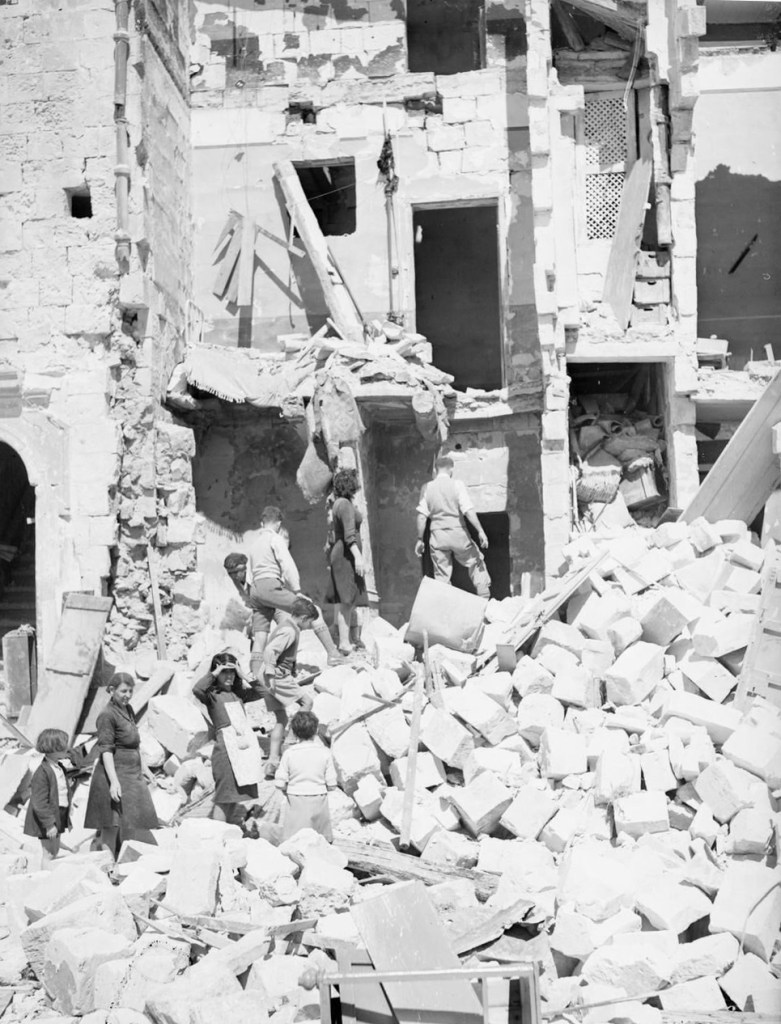
“Fliegerkorps ll, Messina, has done a splendid job in planning and the execution of the attack. Temporary interruptions of the air assault against Malta are caused by switching the attacking forces to convoys — the sinking of which is an indispensable preliminary to success against the island. ln bitter battles, these convoys, except for a few ships, have been destroyed.”
Having buoyed his men to greater deeds, Kesselring decided to launch his main assault from April 2.
With Takali thought to have been knocked out, the Germans turned their attentions to Valletta in April. The bombing was deafening, roiling the earth as if threatening to topple the city into the sea. Mountains of rubble occupied every street, flanked by lines of broken buildings. April 3, Good Friday, was grim. The airfields were hit, and two fighters destroyed on the ground and on April 4, the RAF found itself in the untenable position of having no more combat-ready fighters to scramble. In the absence of the defending fighters, the Germans had a field-day.
The Free Greek submarine, Glaukos, reeling from the deaths of its officers in a bombing raid on 27 February, was preparing to sail when she was hit by bombs and sunk. Most of the crew escaped, baring two men. “Our strength is now down to six operational submarines, and also Sokol and Unbeaten beyond repair,” Simpson reported to naval command.
Fearing for the safety of his remaining submarines, he issued new orders: Move the submarines into one of the nearby creeks and employ camouflage netting to escape detection.
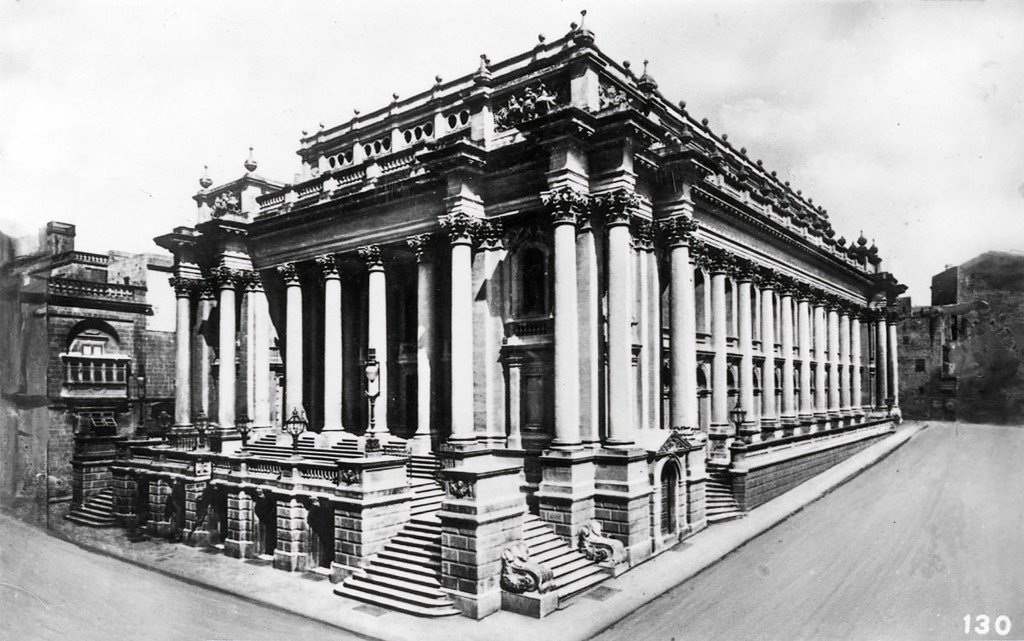
On 7 April, the 23,072 square-foot architectural jewel of Malta, the Royal Opera House, was obliterated, much to the shock of the islanders. “[The Opera House]…was just a heap of rubble,” said a Maltese civilian, Memè Cortis. “I could not believe it. The Royal Opera House was like Covent Garden to us.”

The attack constituted the largest German air raid against Valletta to date and as its legacy, destroyed or damaged 70% of buildings in the capital and at Floriana. The governor’s palace had been damaged again and Dobbie suggested that he and Lloyd move the remaining offices of their headquarters inland.
“Valletta is a stricken city,” wrote The Times of Malta. “All the beautiful old palaces are bombed, all the churches have been ruined, blitzed…hundreds of houses are no more…nearly all shops destroyed…the streets are impassable, stones, dust everywhere…stones are piled high on the streets, often 20 feet high.”

At least 13 Maltese civilians had been killed, including three young girls from a single family. Many RAF pilots were disgusted by the scale of the devastation, their fury outmatched only by their profound inability to do anything about it. Said one pilot, Sgt. Wood: “The fighters want to go off but were not allowed; it was pathetic watching the havoc caused. The morale of the ground-crews and pilots was terrible; no effort was being made by the authorities to do anything and the aircraft were being written off on the ground, time and time again. The pilots were keen to have a try but the people up top just sat them on the ground and let them go to pot on the ground.”
Ships at the harbor are smashed with the cruiser HMS Penelope, of Force K, being so battered that she was nicknamed “Pepperpot.” She was ordered to leave Malta on 8 April and managed to reach Gibraltar two days later.

The Spitfires were powerless to intervene, owing to their limited numbers, poor tactics by Lloyd and sheer numbers of Messerschmitts which swamped them on every occasion. When Air Marshal Arthur Tedder (chief of the RAF in the Middle East) and Sir William Monckton (acting minister of State for the Middle East), visited the island on a fact-finding tour in the latter half of the month, they were staggered to see massive numbers of German fighters and bombers prowling overhead, shooting and bombing at will. Monckton sought to address the growing feud between Dobbie and Lloyd over the destruction of convoy MW10.
Dobbie demanded that Lloyd and other senior officers be sacked. Instead, Monckton wrote to London that Dobbie needed to go. Monckton’s indictment was that Dobbie was becoming “worn out”. he aded that there were a “litany of complaints about Dobbie, including his lack of vigor, excessive concern for civilians, and too much religion — he objects to soldiers working or training on Sundays, for example.” There was also concern that Dobbie could surrender the island to the Axis.
Churchill who had long supported Dobbie was stunned. Churchill nevertheless accepted the judgment and moved to replace Dobbie with a firebrand, General Lord Gort, VC.
Meanwhile, Simpson was staggered to learn on April 14 that his best submarine crew and captain had vanished without a trace during a patrol. This was the famed HMS Upholder which had sunk three submarines, two destroyers, one armed trawler and 15 freighters while operating out of Malta. These feats had elevated her skipper, Lt-Commander David Wanklyn, to the position of Britain’s great submarine ace and had won him a Victoria Cross.
Their loss shattered the Flotilla’s morale to such a degree that not even news of the King’s award of a George Cross to the island a day later could ameliorate their spirits. The George Cross medial itself is immensely prestigious award normally reserved for humans, for acts of great courage in non-combat situations. The award of the medal to the islands, pre-dated to April 15, was a piece of propaganda brilliance.
It is a handsome medal, ranked second only to the Victoria Cross, designed by Percy Metcalf, an English artist and sculptor, with the Metcalf-staple effigy of St. George slaying the Dragon and cast out of gleaming silver with a plain, blue ribbon. By conferring the medal, London hoped to bolster morale — thus keeping the islanders in the fight on the side of the British. Even the official citation was simplicity itself.
The Governor, Malta.
To honor her brave people I award the George Cross to the Island Fortress of Malta, to bear witness to a heroism and devotion that will long be famous in history.
(signed) George R.I.
The Maltese were elated, gratified by the realization that they have not been forgotten by distant Britain. “It is a new thing which His Majesty has done,” Dobbie said in an address to the Maltese. The 17 April edition of the Daily Telegraph recorded the uniqueness of the honor, saying that “this is the first time a decoration has been conferred by a Sovereign on a part of the British Commonwealth.”
In contrast, some dissenting Maltese cried: “We want bread, not the George Cross,” and scattered graffiti popped up across the island, reading: “Instead of the George Cross, increase the bread ration.” Equally outraged were the Italians who described the award as another “preposterous deception by the British Government. Had not our unfortunate Maltese brethren been under the heel of British domination which is being forced on them under the threat of guns and bayonets, we have no doubt as to how the Maltese would behave.”
Beyond the Cross, what improved Malta’s fortunes was the arrival, in the Mediterranean, of the American carrier, the USS Wasp, with additional Spitfire reinforcements. Simpson prayed that these reinforcements would reclaim air superiority over the island to halt the Admiralty’s plans to evacuate his submarine flotilla to Egypt.
Unlike previous aircraft transfers made using pools of volunteers drawn from various units in England, the Air Ministry had planned to send two entire squadrons of Spitfires to the island. This was the brainchild of Group Captain C A Bouchier, Deputy Director of Fighter Operations at the Air Ministry who on March 27 had submitted a memorandum recommending a return to the 1940 policy of sending entire squadrons overseas.
But April 1942 was not the same as November 1940 when Fighter Command, having won the Battle of Britain, could afford to send its best units overseas. Now faced with a resurgent Luftwaffe in France equipped with growing numbers of Focke-Wulf Fw190 fighters, an aircraft locked in mortal combat with the Spitfire Mark V for the title of the best fighter aircraft in the world, RAF Fighter Command was loath to lose its best units. Air Headquarters nominated two middling squadrons of the Auxiliary Air Force for Malta.
The first was No 601 “County of London” Squadron, a unit once so replete with luminaries, celebrities and members of the upper-class, that it was known as “The Millionaires Squadron.” It had little actual fighting experience, however.
It had formed in October 1925 under Lord Edward Grosvenor, an unconventional, aircraft-obsessed member of the English aristocracy. The squadron had romped through the 1920s and the ‘30s sustaining itself on juvenile antics and petty rivalries with other squadrons, notably peppering 54 Squadron’s airfield with toilet paper, pies and chamber pots and squabbling with No 600 “City of London” Squadron over seniority — even though both squadrons had formed on the same day. Much of these childish enmities are ironed out through combat and the replacement of the elites by professional pilots. So egalitarian was the decline of the elites by March 1942, that the squadron was led by a former sergeant of the Voluntary Reserves who had risen through the ranks to become an officer.
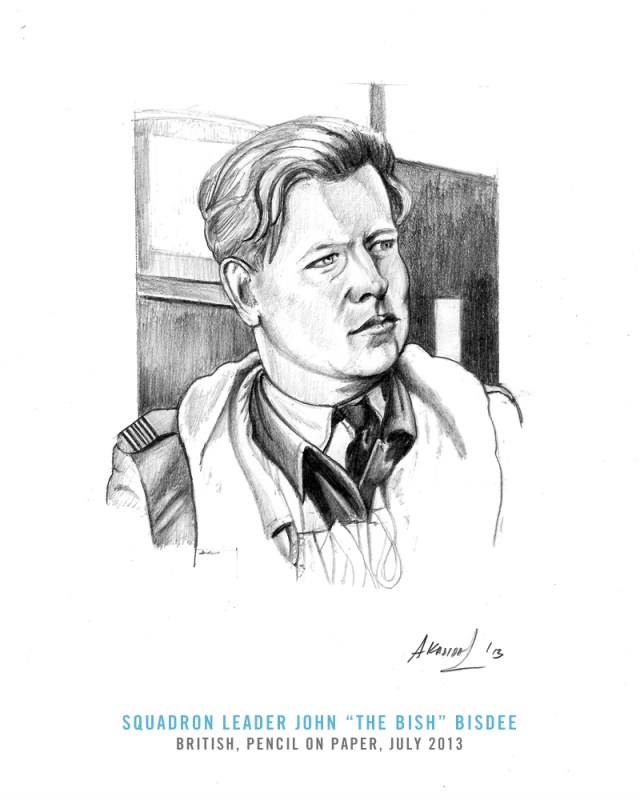
When the squadron was informed that it was going to Malta, the announcement was concurrent with the transfer of seven experienced pilots to other squadrons in Britain, including the skipper, Squadron Leader John Bisdee, who was so appalled that he went to Air Vice-Marshal Richard Saul to have the order quashed.
Bisdee, nicknamed “The Bish,”is a giant of man with a square jaw and a thick tussle of blonde hair. He had a DFC to his name and six confirmed kills to his credit. His flight commanders were lesser mortals of sorts. Hugh Parry was an Englishman who was known to prefix his observations with the word “dreaded” but had not a single kill to his credit; Ken Pawson was only a Pilot Officer but incharge of a flight and Denis Barnham was an artist of some repute whose work had been exhibited in the National Gallery when he was only 17.
As the only son of a family which ran a market gardening business, Barnham was expected to take over the firm. Instead, he convinced his mother to let him take flying lessons in an old Cierva C30 Autogiro when he was 16. He was brought into 601 at Bisdee’s direct request since he needed an experienced flight leader for Malta. Barnham had a destroyed Fw190 to his credit which was more than could be said about the other pilots. Seven were so green that they have not flown operationally at all.

Four had less than 25 hours on a Spitfire and 12 out of 23 had never fired their guns in anger. But while Barnham was one of the few experienced men in the squadron, he had little actual interest in going to war. For one, he had met Diana Firth, an attractive blonde that previous June, and had been so smitten that he had proposed to her the day after they had met.
Firth told him to be sensible, but he had persisted and they were married in January 1942 — with the blessings of Firth’s father, the tough, imposing commander of the 39th Anti-Aircraft Brigade. The resulting move to the island would take a toll on Barnham as did his separation from Diana. Parry would later remember Barnham being reduced to tears by teasing from the other pilots about what Diana could be doing back home.
The second unit, No 603 “City of Edinburgh” Squadron, was in worse shape. Nine of its pilots had no operational experience at all and most of the rest were neophytes to air combat. Yet, the unit’s rookie nature belied its rich history. As one of the first fighter squadrons to equip with Spitfires back in October 1939, the squadron was operational in time to intercept the first German air raid on the British Isles on October 16, when it may have destroyed the first enemy aircraft to be shot down over Britain in the Second World War. The squadron had remained on defensive duties in Scotland until the end of August 1940 when it moved to southern England to take part in the primary struggle of the Battle of Britain. It claimed 98 aerial victories during the battle.
The CO was a genuine aristocrat, Lord David Douglas-Hamilton, whose three brothers were professional flying instructors or squadron commanders. His eldest brother, Douglas, was the first man to fly over Mount Everest while an older brother, George, the sour-faced 10th Earle of Selkirk, had commanded 603 at its reformation in 1938.
Posted to Netheravon as a flying instructor with the acting rank of Flight Lieutenant, David’s easy going nature and his reputation as a boxer endeared him to trainee pilots. Publicly, he had harbored aspirations to join a frontline unit but had been forced to sit out the Battle of Britain as an instructor. He had been granted command of 603 Squadron in December 1941 — but he remained a neophyte to operational flying, having started combat patrols only in March 1942. Out of this three flight commanders, only Flight Lts. Bill Douglas of A Flight and Lester Sanders of C Flight had seen combat. Flight Lt. John Buckstone of B Flight had been a ground officer until 1941.
On April 12th, the 22 pilots of the squadron were transported by bus to Port Glasgow, where they were confronted by the awe-inspiring visage of the USS Wasp, while members of 601 Squadron arrived by train.

The carrier was hoisting 52 Spitfire Mk Vc aircraft onboard, all painted sea gray and blue with large Vokes filters and armed with four 20mm Hispano cannons and four .50 Browning machineguns. Gracie was already onboard and gazed upon the newcomers with a discerning eye. He scared the life out of some by painting an accurately austere picture of life on Malta with all its shortages, prompting the “panic buying of razor blades, shoes, underwear, soap, tobacco and cigarettes.”
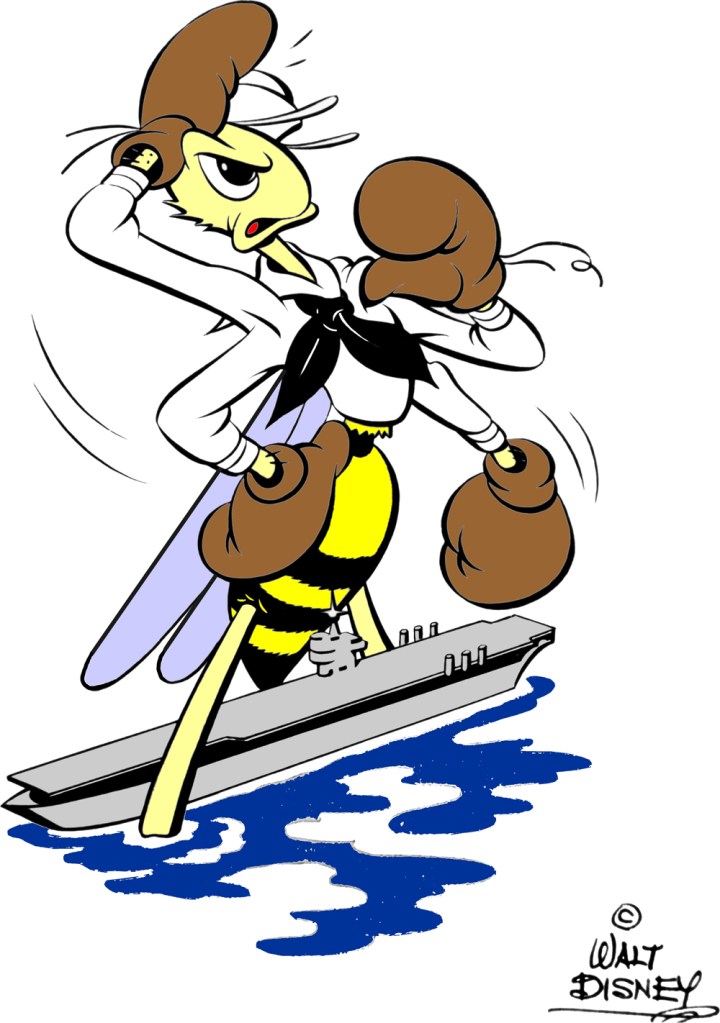
The lodgings on the Wasp were almost luxurious, with high-quality food compounded by copious amounts of coffee, eggs, tea and chocolates. But many are stunned when instead of whiskey and tonic, they were handed Coca Cola and fruit punch because in keeping with an American puritanical regard of the drink, Wasp was a “dry-ship.”
Barnham found himself under earnest interrogation by American naval officers who were keen to how what it is like to fight the Messerschmitts and how many planes Barnham had shot down. Their queries were blunt and without a trace of innuendo but Barnham turned red when they demanded to know why he had no medals. He had to remind himself that Americans were freely given medals for such things as “shooting prowess and another for being on the western seaboard of America.” He had half a mind to tell them that Bisdee’s DFC “really was a medal,” awarded for heroism and achievement.
The Americans, for their part, were bemused by the British penchant to address all officers as “Sir” when “Chief” would have sufficed. The carrier’s skipper, Captain J W Reeves Jr, was less than impressed with British efficiency. When the Spitfire slipper tanks were found leaking fuel all over his hanger floor, he halted all loading of additional aircraft unless the problem was rectified. The British burned with humiliation at thought that they had come up short in front of their American cousins.
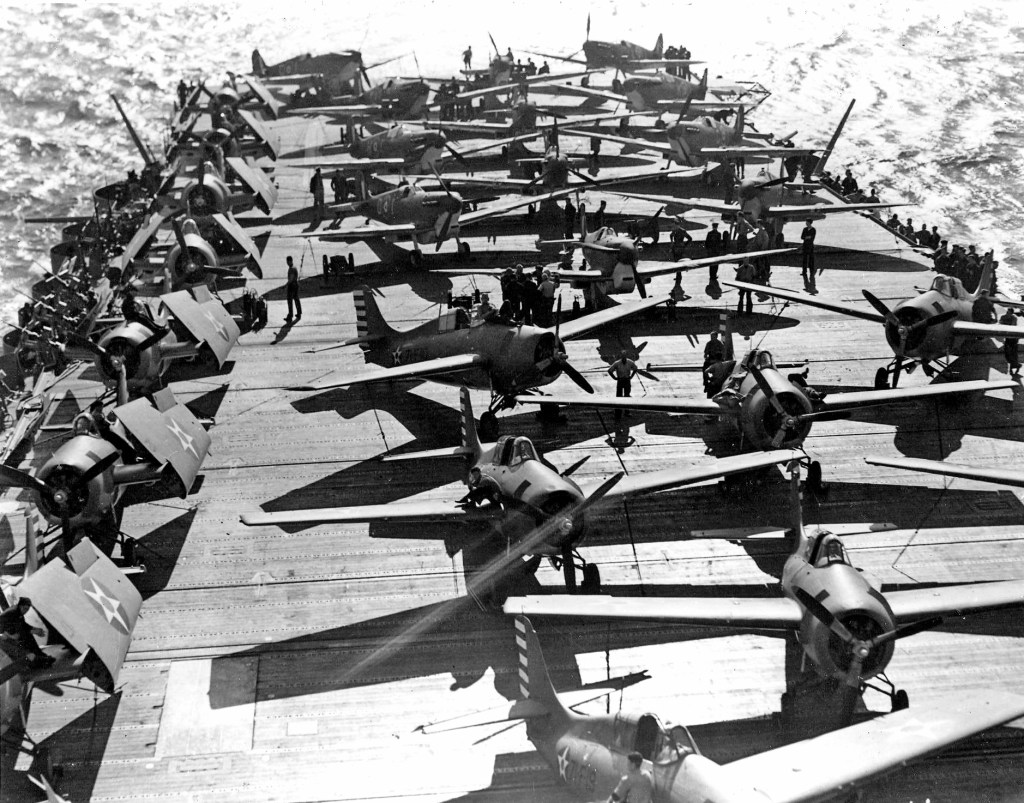
With no time to lose, the carrier set sail for the Mediterranean on 13 April. The operation was codenamed ” Calendar.” To secure maximum hanger space, 19 Grumman Wildcat fighters of Wasp’s VF-71 (fighter squadron) were lashed up on deck. The carrier reached the straits of Gibraltar in the early pre-dawn hours of the 19 April but she and her escorts did not divert to “the Rock”. They chugged on eastwards.
To the east, bad weather had subsided over Malta by 18 April. Hordes of German aircraft once again took shape over the island.
Lloyd watched enraged as he had no fighters left to send up. At Hal Far, two Hurricanes were destroyed. At Luqa, two large aircraft (a Wellington and a Hudson, both under repair) were hit and burned out. A fair number of men were killed or wounded. In return, the ack-ack gunners claimed one Ju88 shot down and a single Stuka. The situation repeated itself on the 19th when again there were no fighters to scramble. The guns did their best to hold back the attackers, darkening the sky with ack-ack fire and shooting down three Ju88s. But they were unable to prevent 436 tons of bombs from being dropped, mostly on the AA batteries which lost 13 men killed and dozens injured. Civilian locations were also unspared. At Hamrun, bombs land on the St. Paul’s Home for the Elderly, killing 34.

As the guns waged a desperate battle, British radar plotters send word of an incoming force of friendly fighters. These were six cannon-armed Hurricane Mark IICs of No 229 Squadron from North Africa. Led by Flight Lt. Robert C. Dafforn DFC, a rail-thin officer who towered nearly 6’6” and whose broken-face looks and hook nose were uncharacteristic of conventional handsomeness, the flight made a nerve-racking 720-mile journey from Gambut airfield. To some, their safe arrival was unsurprising. Dafforn knew his stuff. He was a veteran ace of the Battle of Britain where he had shot down six aircraft, shared in the destruction of two, and damaged or probably destroyed six others. Yet, he had reached his pinnacle of his career as a fighter ace. As an administrator and an instructor, however, his life was just beginning. On Malta, Dafforn found himself promoted to Squadron Leader.
Fifty-two Spitfires launched from Wasp in the early morning hours of 20 April and reached Malta just as another massive air-raid developed. Low on fuel, the Spitfires had no choice but to land and become sitting ducks. Only 27 were operational by the following morning. A day later, only 11 remained airworthy and within 72 hours, none remained.
Lloyd, who was anxious to meet the new pilots on 20 April, sped in his car to Takali only to have his tires shredded by bomb splinters. When he finally reached the dispersal, he found the pilots of No 603 in a state of shock. The station commander informed him that most of the new Spitfires were unprepared for combat; their guns were dirty, they had broken radios and the new pilots were raw. Lloyd was irate.
That night, a great mass of fighter pilots, both new and old, were summoned to Malta’s Xara Palace to meet Lloyd. Barnham recognized old friends and acquaintances in the crowd — Peter Nash, Stan Grant and Johnny Plagis. Silence descended on the room when Lloyd entered. The pilots stood up. Lloyd was dressed in his tropical dress uniform, the “double-encrustation of gold on his peaked cap,” a thing of intimidation.
With a theatrical flourish, he folded his arms and gazed steely-eyed around the room, a hand slowly tilting the peaked cap to one side. He hovered over the table by the door and placed his massive hands on it. “I think, gentlemen,” he said finally, “That the Germans have welcomed you in a far more striking manner than I could do myself. I know the Germans. I fought against them in the last war. I’m fighting them again in this; they’re the same lot, cowardly and bullies.”
At that moment, a high-pitched whine began. The pilots looked up. The whine took on the noise of an approaching freight train. Lloyd paused and follows the noise with his head. A deafening explosion erupted outside, shattering the windows. A second massive explosion followed, closer this time. Dust filtered down from the ceiling. More whines grew outside in the night sky. Some of the new pilots, including Barnham, began to pray.
“As I was saying,” Lloyd said, without missing a beat. “The Germans are bullies and incredibly foolish — the manner in which they are conducting their offensive against the island shows us that. You are here to shoot down his bombers…Malta is like the famous statue of Achilles in Hyde Park, London… our sword has been blunted but we must sharpen it…” The pilots stared in awe. Their new commander was clearly no ordinary individual. He was the coupling of a showman and a Tyrolean strongman.
Meanwhile, a realization that new Spitfires would soon be destroyed forced Simpson to a decision. To Leatham, he declared his intention to evacuate the Tenth Flotilla from Malta. Leatham concurred and informed Vice-Admiral Henry Pridham-Wippell (acting commander of the British Mediterranean Fleet) about this. The submarines Urge and Umbra, which were out on patrol, were recalled to Lazaretto on 20 April. When Umbra returned on the 25th, it is with her Jolly Roger unfurled. On the 19th, she had torpedoed and sunk the 4,219-ton ship Assunta de Gregori.
Meantime, up in the skies, the fierce battles continued. On 20 April, eight Spitfires, led by Gracie, scramble at 12.20 to meet an incoming raid. With him were Bisdee and Barnham. Ten minutes after 126 Squadron was airborne, eight Spitfires from 249 Squadron followed.

Several German Ju88s come into view. Barnham counted at least thirty. He was giddy with excitement. He gave one a quick burst of his cannons but then his Spitfire strangely buffeted. A Ju88, monstrous in its proportions, came up from under him and turned to the left. Barnham fired again at his original target and saw puffs of smoke. However, he was distracted by three Messerschmitts coming straight for him, guns blinking. The Germans missed and swept past. Another Messerschmitt popped up in front. Barnham lined up to open fire when a “gigantic shape, all rivets and oil streaks — the underside of a Me109” role up from below and “blotted out the sky.” Imagery of that event was so stark that it would form the basis for one of Barnham’s paintings.
The original Messerschmitt was still before him and he poured fire into it. The German machine spewed a clot of black smoke and seemed to lumber sideways and fall. Barnham wanted to follow but the shapes of other Me109s entered his mind. Time abruptly blurred. His engine exploded into flames and black smoke flooded into the cockpit. The Spitfire went into a spin.
Barnham pawed at the controls. He discovered that the aircraft was still responsive to his touch. He pulled out of the deathly dive and headed for cliffs which loomed ahead. Up above, the Me109s had realized he had recovered. They hauled after him in chase. But they were too late. Barnham crash-landed at Hal Far. He was taken to the dispensary in a state of shock.

On 21 April, Lt. Walter Zellot of I/JG53 tracked a Spitfire which was busy attacking a Ju88. Zellot closed in on his prey. Having graduated from training in November 1940, Zellot had missed the Battle of Britain by a hair but had found glory over Russia in 1941, flying operations from the first day of Operation Barbarossa, the colossal 22 June 1941 invasion of the Soviet Union. He had ended that day his first confirmed kill, a Russian I-16 Rata fighter. By July, he had ten victories, and added another two before his unit was recalled to Germany that September. In November, I/JG53 relocated to Sicily, where it began operations against Malta. Zellot had shot down a single Hurricane on December 12, but his greatest success over Malta would take place in the next few seconds.
Zellot came up behind his quarry. He tentatively fired on him with his machineguns to avoid hitting the Ju88. The British pilot, however, remained oblivious and maintained a steely focus on his target. Zellot swung right and fired at the Spitfire from an angle while turning slightly left, scoring a direct hit. Abruptly, his target – “The Bish” Bisdee – awoke to the danger on his tail.
“He tried to get away,” Zellot said. But by executing a sharp left turn, Bisdee exposed the entire upper surface of his aircraft to his assailant. Zellot was about to open fire when he saw Bisdee climb out of his cockpit and jump. The Spitfire tumbled like a broken leaf straight into the water. When Bisdee’s parachute opened, it tore the webbing harness from his shoulders. Only by deftly hooking a leg around a loop did Bisdee save himself from falling to his death. He fell head-first into a patch of oil-slicked water. Zellot observed Bisdee safe in the water before flying away. Bisdee paddled back to Malta in a state of exhaustion.
By late-April, Malta was in a state of demoralized paralysis. Over 2,000 tons of bombs had hit the island in March, killing 231 civilians and seriously injuring 281. Nearly 300 others were wounded. April is worse. The island is pummeled by 6,727 tons of bombs, giving it the reputation of being the most bombed place on earth. A total of 339 civilians had died in addition to 208 servicemen killed and 550 people wounded. In a place like Malta, where communities are often close-knit and live in densely-populated neighborhoods, such losses in a single month were inconceivable.
Simpson’s 10th Flotilla began evacuating the island on 26 April. By 30 April, all that remained of the RAF fighter force were seven operational Spitfires and five Hurricanes. Kesselring gleefully reported that the “island was ripe for conquest.”
Hitler promised to throw his support behind the invasion but then prioritized Rommel’s assault on Tobruk, now codenamed Operation Theseus.
Hitler proposed that Theseus, which was due to launch on 26 May be given maximum priority. He added that once Tobruk was safe in German hands and Rommel was on the Egyptian frontier, Herkules could commence against Malta.
Tobruk was to be captured by 18 June; Herkules was to launch by July 10 or 18. Mussolini, well aware of the importance of Malta and under pressure from the Italian press to invade, should have objected to this decision. Instead, he stayed mum. It was Kesselring who argued for Herkules only to have Hitler tell him: “Keep your shirt on, Field Marshal. I’m going to do it!”
In retrospect, Kesselring should have lost his shirt.
Back in England, George Beurling was transferred to a British squadron south of the “big smoke” — London, and rapidly becomes disillusioned with the members of his unit.
Placed at the tail end of the formation during operations owing to his low rank, he was almost shot down and killed twice because he was unable to convince his squadron commander and the wing leader to abandon their rigid adherence to formation flying. When he did break formation to save his skin and attack the Germans, he was reprimanded. The other pilots in the squadron loathed him because of his tendency to abandon the flight and expose their flanks.
In their minds, it was better for Beurling to be shot down than break formation. When Beurling retorted that he had shot down a German fighter single-handedly, the other pilots scoff, convinced that here is a “smart pilot only trying to make a name for himself.”
Out of frustration, Beurling volunteered for overseas service. By 22 May, he was on his way to the great unknown — Malta.
Island life was a mosaic of injustices and barbarisms. German fighters routinely strafed civilians walking on roads or working in fields, Commonwealth pilots shot down air ambulances while ordinary Maltese took to murdering shot-down Axis aircrews. On one occasion, the rough, lewd Wing Commander Stan Turner was ashen to discover the heads of three German aircrews in a large pot in a Maltese bar. At another time, when Admiral Cunningham’s wife challenged her Maltese steward on the criminal nature of their killings by declaring that murder is against the law, the man retorts: “International law not in Malta, Signora.”
The Anglo-Maltese relationship, once amiable before the war despite some Maltese calls for independence, began to take a turn for the worst. Crude anti-British slogans begin appearing all over the island carrying a common theme: “British get out.”
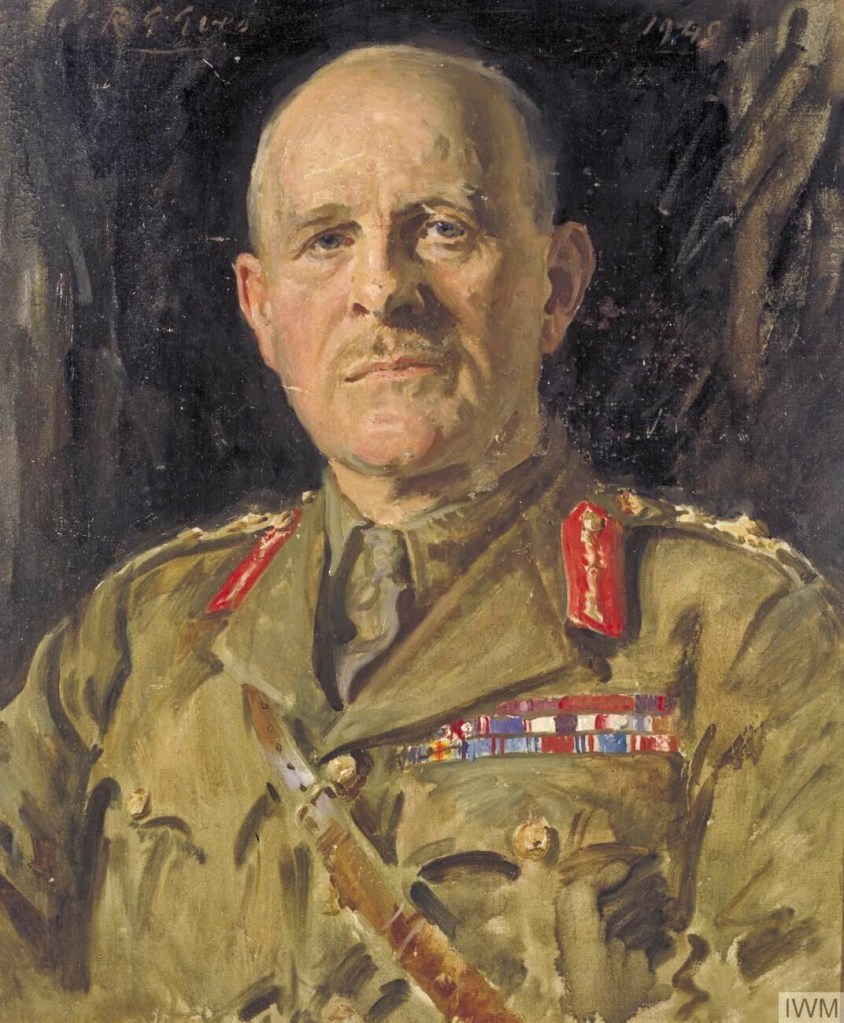
The downturn was exacerbated by the rampant thievery of British war material and personal possessions by Maltese servants and workers. As the island culture threatened to unravel, Lord Gort arrived on May 1, to take over from Dobbie who returned to England. Upon arrival in Britain, Dobbie went into a hospital for exhaustion. Rumors swirled on Malta that Gort had been brought in to surrender the island to the Germans.
At the airfields, the pilots were in a state of demoralized paralysis. In this period, the Axis had mounted 2,100 bomber sorties against Malta’s docks, radar stations and aerodromes, damaging the three airfields to such a degree that RAF fighters taking off or landing faced a danger equal to that of dogfighting.
“This was the juncture when, collectively, we came nearest to dying,” said Flight Lt. Laddie Lucas of 249 Squadron. “And even, for the first time, thought we might die. Our hopes which had risen high were cruelly dashed.”
Gracie asked for permission to return to England to organize a second airlift.
For the pilots, life on the island deteriorates each day. Food is poor in quality, Maltese women prudish and pious, the weather often a display of extremes and the combat lethal. A squadron on duty on any particular day operates the ramshackle collective of fighters. Pilots of the first shift awake for a 3.30 AM quick breakfast and then sit in their planes on readiness until late into the afternoon.
At 1 PM, the second flight took over. As the day wore on and the sun rose higher and higher, the metallic parts of the fighters heated up, channeling hot air into the cockpit which turned into a stifling furnace. With summer on the way, the pilots often took to waiting in their seats with nothing on but a sleeveless shirt, a “Mae West,” a pair of shorts, a pair of boots and a sidearm — just in case they ran into an angry Maltese mob.
I wonder what it is all leading to. Are the Bosch going to content themselves with smashing the island by means of aerial attack, so that it will take all summer to repair before it is any more use to us? Or are they going to invade?… If they start to turn their dive-bombers from the present targets onto the batteries and army shore defenses, I shall know that invasion is coming. At the moment the odds seem against it… If [the enemy] actually intends invasion, [why] go to such trouble to destroy the dockyard from the air? He would not trouble so much about damaging the surfaces of our aerodromes either… His aim would be at the aircraft and ground defenses, not the surface that he requires for transport aircraft. Time will… We must wait and see
Pilot Officer Sonny Ormrod, 185 Squadron
Just when it appears there was no end in sight, the RAF was thrown a bone. On 26 April, the Special Liaison Unit at Lascaris Bastion, which is responsible for handling classified Ultra intelligence, informed Lloyd that several units of Fliegerkorps II were preparing to leave Sicily. Lloyd was thrilled but could not share the news with his pilots. And in any case German attacks remained so strident that they will belied any news of a withdrawal.
This was prudent. Over Malta, the situation remained unchanged. By April 30, all that remained of Malta’s fighter force were seven serviceable Spitfires augmented by four or five Hurricanes. Dafforn’s 229 Squadron had effectively lost all of its aircraft.
The last remnants of the 10th Submarine Flotilla also departed Malta on 4 May, leaving behind a skeletal force at Manoel. The exit of the flotilla, however, was marked by tragedy. One of the last submarines to leave, HMS Olympus, hit a mine and sank off Malta. Nearly all of her crew and passengers escaped the vessel but only nine of the 98 people who reached the surface survived the long swim to shore. In Alexandria, meantime, Captain Simpson ruminated that half of his command had been wiped out in three-and-a-half weeks.
The Bombing of Malta, February to April 1942
| February | March | April | |
| Takali | 120 | 482 | 841 |
| Luqa | 218 | 486 | 804 |
| Hal Far | 174 | 347 | 750 |
| Kalafrana | 7 | 30 | 196 |
| Dockyard | 152 | 314 | 3156 |
| Others | 322 | 488 | 980 |
| Total tonnage | 993 | 2147 | 6,727 |
The April bombing, by location
| Dockyard + Three cities | 3,156 | Hal Far | 750 |
| Takali | 841 | Luqa | 805 |
| Kalafrana | 196 | Elsewhere | 980 |
With the bulk of Fliegerkorps II transferring in North Africa to support Rommel’s assault on Tobruk, the stalwarts and the Italians shouldered the burden of maintaining the air offensive against Malta. The attacks continued day and night.
The tempo of life here is just indescribable. One lives here only to destroy the Hun and hold him at bay; everything else, living conditions, sleep, food and all the ordinary standards of living have gone by the board. It makes the Battle of Britain seem like child’s play.
Pilot Officer Herbert Mitchell of 603 Squadron
The tempo of operations claimed the life of one of Malta’s first Spitfire aces on the afternoon of 4 May. The affable Norman “Mac” McQueen who had flown in on Operation Spotter in March led a force of four Spitfires from 249 Squadron (soon joined by another four Spits from 601 Squadron) against an incoming raid. This Axis force comprised five Cant Z.1007s, ten Me109s from III/JG53 and five Macchi MC202s. The combatants made contact south of Gozo.
Sgt. Paul Brennan maneuvered violently to escape the Germans which swarmed the flight. Brennan and his wingman, Pilot Officer Ossie Linton became separated from MacQueen and his wingman, Pilot Officer Fred Almos, a rookie American. Brennan then found himself cut off from Linton who had four Me109s furiously firing at his tail.
A German fighter tried to nail Brennan from below, but missed and overshot. It appeared directly in front of Brennan who hammered it with his guns. The Me109 fell to pieces, giving Brennan his sixth victory of the war.
MacQueen, meantime, was having troubles of his own. Chasing after a Me109, he attracted the attentions of two Messerschmitts who pursued him silently, without shooting. Almost every RAF pilot in the vicinity began shouting a warning which MacQueen either ignored or failed to hear because of radio problems. The first Messerschmitt overshot MacQueen’s Spitfire, but the second, flown by Uffz. Walter Manz, pulled up under the Spitfire and raked its belly with fire.
Sgt. Brennan, who was nearby, watched in horror as MacQueen’s fighter gave a shudder and lost a thousand feet of altitude.
“Mac,” Brennan cried over the radio, “If you’re not okay, for God’s sake bail out. I’ll cover you.”
MacQueen did not respond. The Spitfire flew on, seemingly under control, save for a discomfiting trail of wispy smoke.
MacQueen returned to Takali and circled the airfield as if to land, but then his fighter gave an abrupt lurch. Douglas-Hamilton who was watching from the Mess verandah at Takali, saw the nose of MacQueen’s Spitfire going “forward and the machine diving like a stone before bursting into flames upon hitting the ground a mile from the runway.” A lump formed in Douglas-Hamilton’s throat.
With eight confirmed victories, MacQueen was Malta’s first Spitfire ace to die in combat. He was not Malta’s first Spitfire ace, however — that honor belonged to his friend, Peter Nash. MacQueen’s death threw the island fighter squadrons into despair. Brennan had an especially close friendship with him. A friendship between an NCO and officer was untenable within the strict social structure of squadron life in England but a testament to the camaraderie of the fighting men on Malta.
Said Brennan: “Everybody is down in the dumps about Mac. We feel his loss very keenly. He is one of our finest pilots…Mac’s death had a sobering effect on me. I had begun to think I knew all there was to know about air fighting. I had shot down my sixth Hun that very day. The death of such an experienced and capable pilot as Mac brought me to a realization that I could not continue to take the risks I had been taking… I had held a poor opinion of the shooting ability of the Hun fighter-pilots… Now I knew I was wrong, and that I had, rather foolishly, under-rated the Hun.”
Much blame was heaped on MacQueen’s wingman, Fred Almos, who was thought to be flying too close to MacQueen to adequately protect him. He was banished to an all-American flight which was formed within 126 Squadron that same day.

Among the most respected of the Second World War histories are those written by the participants themselves. The literary contributions of Virgil Paul Brennan (6 March 1920-13 June 1943), an NCO pilot who destroyed 10 enemy aircraft in his career (all over Malta), amounted to his writing “Spitfires over Malta,” a 1943 book penned in collaboration with fellow Malta ace and friend, Sgt. Raymond Hesselyn. Sent to Malta during “Spotter,” Brennan joined 249 Squadron where he quickly made friends. Many remembered that while there was aggression in Brennan’s manner, “he had an easy-going nature, an engaging sense of humor and was loyal to his friends; his flair for oratory made him a forceful debater.” He was killed in New Guinea during a landing when he accidentally wandered into the right lane of the runway, and was struck by the Spitfire following behind. (Akhil Kadidal)
At Churchill’s behest, the American carrier, USS Wasp was again sent into the central Mediterranean with another contingent of 50 Spitfires. Within the force was an entire flight from No 611 Squadron led by Flight Lt. J P Winfield.
Group Captain Bouchier at the Air Ministry had abandoned his decision to send whole squadrons to Malta. Instead the squadrons in England had been asked for volunteers or asked to volunteer some of their men, and the squadrons had responded eagerly — perhaps too eagerly. Seizing the chance to rid themselves of their maligners, their troublemakers and their greenhorns, they had dispatched a great pool of unqualified pilots to fly the Spitfires to the island.
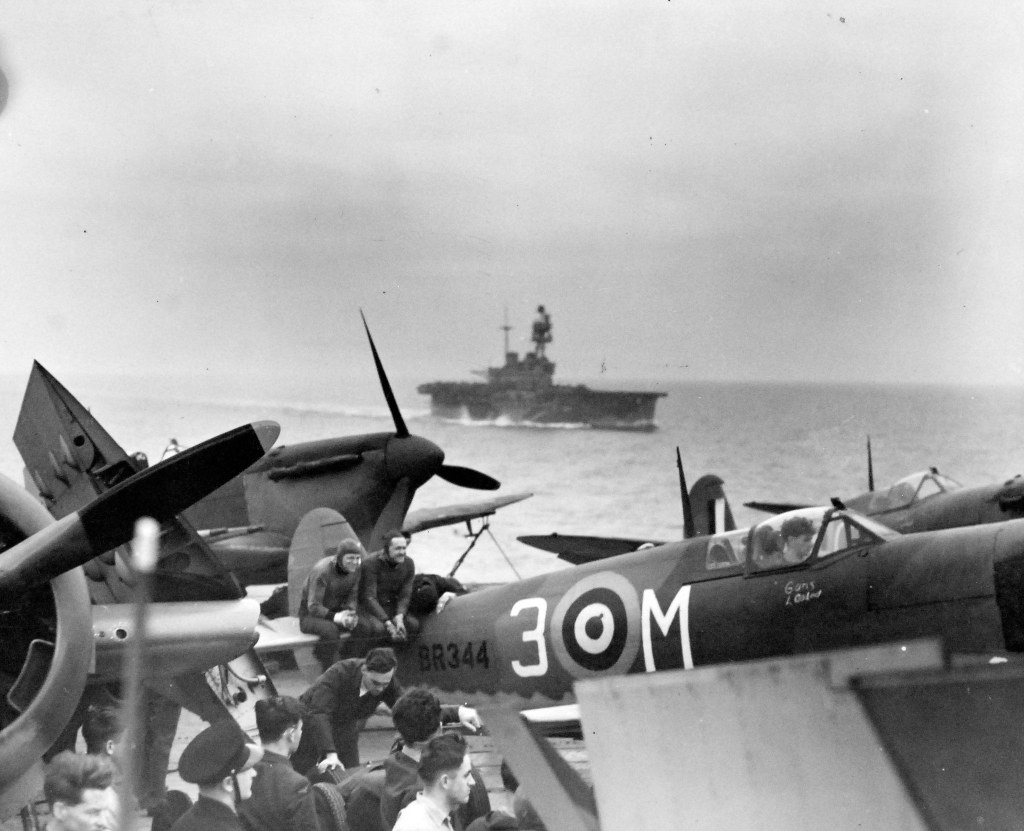
More than half of the men are “colonials,” including 25 members of the RCAF. One of these was Pilot Officer Jerrold “Jerry” Smith, a Canadian with a reputation for mediocrity. His superiors in 152 Squadron had happily placed him in the rota of the Malta operation, codenamed “Bowery,” although Smith himself was loathe to go.
A bevy of 11 ships joined the task force like lapdogs joining a hunting party, among them a repaired Eagle, hauling a further 17 undelivered Spitfires. Also included was an Abdiel-class fast minelayer, the Welshman, carrying 340 tons of supplies. This included medicine, cement, flour millet, tinned camel meat, powdered milk, telephone wire, primers, 10 tons of mail, 72 crates of smoke-making cannisters which the island has never possessed, ammunition, 96 Rolls-Royce Merlin engines and 123 passengers, out of which 100 were RAF technicians.
A sense of urgency overtook the crews of the ships to get everything and order and sail before dawn came and revealed all the Axis spies at Algeciras.
They do not know that the operation has already been compromised by dispatches from a US intelligence officer in Cairo, Lt-Colonel Bonner Fellers. After sunset on the 7th, Welshman began to don a disguise to make use of her class’s decidedly non-British appearance.
She fitted plywood bulkheads to give her an elevated forecastle and disrupt the ship’s flush deck lines to give her the appearance of being the Vichy French light cruiser, Leopard. The Leopard’s three funnels are unevenly spaced, her masts are raked, and she had a starkly curved stem and altered gun positions. The crew also added cowls atop her three smoke funnels. It was a disguise first used by Welshman’s sister ship, Manxman, during a cargo run to Malta in December 1941.

Manxman’s disguise had gone so far as to provide 100 of her crew with French naval uniforms and a tricolor jacket for the ship’s black cat. The disguise had worked, but then again, Manxman was a master of disguise. In July 1942, she had even disguised herself as an island in the Indian Ocean and had gotten away with it.
The problem in May 1942 is that Leopard was no longer a Vichy ship, having defected to the Allies and following a refit had one of her funnels removed. But the British Admiralty was determined to try the disguise again. By 3 AM on the 8th, Welshman’s disguise was complete. The fleet took to the sea before morning broke and was collectively known as Force W.
Among the great clusters of Spitfire pilots on Wasp were two Malta veterans, Stan Grant and the swarthy Ron West. Aboard the Eagle was Stan Turner, in overall command of the flight from 611 Squadron. Three other Malta veterans were also at hand, but with a surplus of Spitfires available for dispatch were ordered to remain on Gibraltar to lead a follow-up “club run” later in the month.
Malta had been toiling to avoid the fiasco of Operation “Calendar.” Gracie, who had been in London weeks before, shouting and pounding his fists in the great corridors and offices of Whitehall, all in demand of better organization and air-tested Spitfires, was back on Malta to oversee last-minute preparations to receive the new aircraft.
The original turnaround time for the Spitfires after landing on Malta was to have been 30 minutes. But Gracie demanded a 15-minute turnaround for the new arrivals. It was decided to turn every pen into a self-sufficient unit, each complete with two airmen assisted by two soldiers, and each with stockpiles of glycol, fuel and ammunition. Each arriving Spitfire was to be met by a runner to guide the aircraft to its respective pen where a veteran Malta fighter pilot would be waiting to take over the new plane. Nearby slit trenches were to be occupied by soldiers, airmen and all off-duty pilots, each armed with a Lee-Enfield rifle or a Bren machinegun, with no caveat on ammunition expenditure. The pilots and groundcrews were to operate at their pens all day long, with meals delivered by trucks.
On the morning of the 9 May, Wasp and Eagle prepare to launch their aircraft. The first man off was Stan Grant at 6.43 AM who took to the air effortlessly. His flight presaged a successful operation, but misfortune struck several pilots.
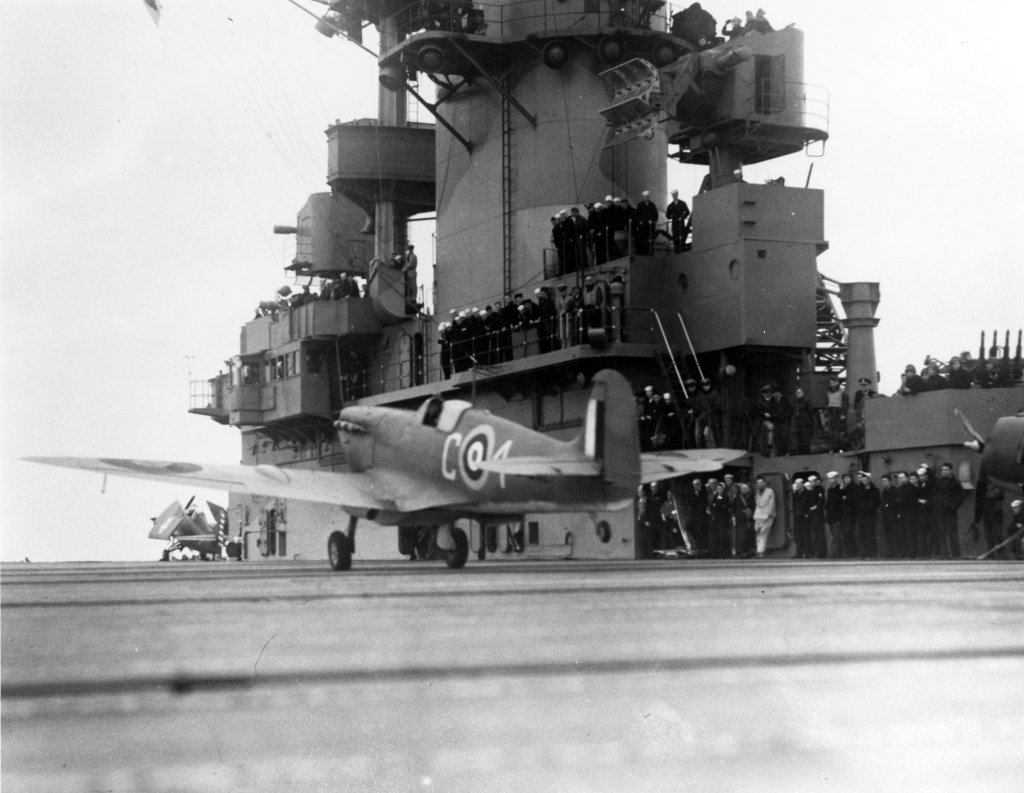
Three Spitfires on Wasp are found to have mechanical problems and were stricken from the flight roster. The 23rd aircraft failed to gain enough momentum during takeoff and fell into the sea ahead of the plowing carrier and went under the bows. Its pilot, Sgt. R D Sherrington was killed.
Another Spitfire flown by Pilot Officer Jerry Smith made it airborne but then it suffered a fuel pump malfunction. Smith was asked to bail out as the Spitfire did not have arrestor gear to make a deck landing on the carrier.
But Smith radioed that he would try a return landing. The Wasp’s skipper, Captain Reeves, ordered that the deck be cleared. To everyone’s amazement, Smith made a perfect landing on the deck, stopping six feet from the edge. The feat would earn him the admiration of the American naval aviators. US Lt-Commander Douglas McCampbell, a Landing Signal Officer aboard the carrier, and later the top American naval ace of the war with 34 confirmed Japanese kills, approached Smith and handed him his cap.
“I take my hat off to you,” McCampbell said.

Another man on board, the Hollywood actor Douglas Fairbanks Jr, who was serving as a US Naval Liaison officer to President Roosevelt, took Smith aside and offered him a glass of whiskey from his private stash on the officially “dry” Wasp.

Back on Malta, Flight Lt. Anthony “Tony” Barton was commanding No 249 Squadron in Stan Grant’s absence. Barton summoned the surviving pilots of the squadron together. “This is it,” he had told the men. “Half of the aircraft will land at Takali and other half at Luqa… The minute the aircraft touches… ground crews have been ordered to tear off the long range petrol tanks, and begin pouring petrol from four gallon tins… Our task is to intercept the enemy bombers. The minute that our radar picks up bomber strength building up over Sicily every aircraft will become airborne. We must divert them from the targets [the new Spitfires]….With luck, we can turn the tide of this — our little war.”
Two Spitfires went missing while en-route to Malta, but the remaining 60 fighters began arriving over the island between 10.30 and 12 PM.
Grant led the first 16 from Wasp to Takali; Another pilot, Flight Lt. Ron West led the third group to Luqa while a new arrival Flight Lt. R H C Sly, an Australian, led the second group to Hal Far. Turner and two other groups also landed at Takali and Luqa. There were welcomed by a reception committee of Me109s. Hurricanes from 229 Squadron attempt to hold the Germans at bay.
A Spitfire came into to land, its wheels and flaps down. Paul Farnes (now a Squadron Leader), spotted a Me109 moving into attack position. Farnes violently turned his Hurricane towards the Messerschmitt, firing frantically until the German broke off. Other Hurricanes and Spitfires harried other Germans. They shot down one Me109 for certain, allowing the first wave of Spitfires to land safely.
No sooner were the new Spitfires down when Gracie’s procedures kicked in. The new arrivals were rearmed and refueled within four minutes. Veteran pilots on Malta took the control of the new arrivals and in many cases, the new Spitfires were ready for combat within seven minutes. It was a remarkable achievement.

At 10.55, the first 11 Spitfires took off under an ack-ack umbrella thrown up by the army’s AA gunners. One of the first pilots airborne was Gracie. Peter Nash shot down one Messerschmitt and probably destroyed another, but the British lost one of their own when Pilot Officer “D’Arcy” Milburn (a Hurricane pilot of 185 Squadron) was shot down while landing.
Twelve Spitfires were due to scramble on that first sortie, but Sgt. Paul Brennan found himself in a new Spitfire with a flat tire. The aircraft was made ready by 11.15 AM, when a second wave of Germans arrived. “We all thought this was it’,” Lloyd said. The island’s future was at stake. Kesselring was trying to destroy all the Spitfires on the ground.
Brennan prepared to to taxi out but saw bombers overhead. The ground crew yelled for him to get out of the machine. Brennan snapped open his straps and jumped out the cockpit, only to have his head jerked back sharply. He fell backwards. He had forgotten to unplug his radio lead. He dove into a trench nearby just as the bombs begin to explode. A mechanic nearby calmly blazed away at the Germans with a rifle.
Some 31 Spitfires scrambled during this second raid, led by Flight Lt. Ron West. An airman, seeing such a massive force of Spitfire take off, remarked: “Heavens, look at the fog.”
Hal Far was in chaos. A swarm of Messerschmitts strafed the airfield even as the AA gunners fought a desperate battle to keep them bay. In the middle of this maelstrom the second group of Spitfires attempt to land. Flight Lt. Sly had just landed when he saw other members of his flight under attack. He opened the throttle and dashed down the runway to help. He ran out of runway. His Spitfire clipped the top of a dispersal pen and crashed in a mass of flames. Sly was pulled from the wreckage but died.
Junkers Ju88s arrived and the explosions churned the earth into a great debris-swirling cloud. The incoming Spitfire pilots were horrified by the sight which confronted them. The island seemed ablaze, bracketed by miniature volcanic-like eruptions. The sky was yellow and red with flak-bursts as small dark objects dart and wheel through the violent firmament.
The radio was populated by cries of “Spit, break! Break! Watch out behind you! Break,” without mentioning aircraft by their code letters. This added to the chaos as a very Spitfire pilot listening broke for cover.
The 31 airborne Spitfires could do little to stem the attack. The Axis raid killed two civilians and three soldiers at Hal Far and left the airfield non-operational for hours. The flight leader, Ron West, was almost shot down by Me109s.

By 2 PM, the raids had quietened down and those Hurricane pilots who had never flown a Spitfire before, listen to drills by experienced pilots who had . The pilots of 185 Squadron, who had handed in their Hurricanes to 229 Squadron on the previous day, were due to take over the bulk of the newly arrived Spitfires.
“It had been intended that we should not fly them immediately on operational lights,” explained Pilot Officer “Wiggles” Wigley. But the Hurricane pilots are anxious to fly the Spitfires. They appealed to Lloyd to take over the Spitfires immediately and received permission to do so. Pilot Officer McKay conducted cockpit drills using a derelict Spitfire in a belated attempt attempt to instill some familiarity with the type.
The haste, however, would cost some of them dearly. While combating a raid at 4.20 PM, the Australian Sgt. Gordon Tweedale, was shot up and sent hurtling to his death by Lt. Erich Beckmann of 9/JG53. He had been flying Pilot Officer Cy King’s Spitfire at the time. The fighter fell into St. Savior Street in Lija where it also killed a Maltese gunner, Seraphim Cauchi. “Within hours of arriving off the Wasp, my aircraft and the personable Aussie who flew it were gone,” King lamented.
Tweedale has the dubious honor of being the last Hurricane ace on the island to die. He had seven victories to his credit. He was awarded a posthumous commission and his family was given his Distinguished Flying Medal (DFM).
In all, eight Axis air raids struck Malta that day, but covered by the ack-ack guns, the RAF destroyed 11 of the enemy, in return for four Spitfires shot down. Yet, the veterans and the islanders, long used to seeing overwhelming numbers of enemy aircraft in the skies above, took heart from the seeing a profusion of Spitfires airborne and in battle.
Lloyd, however, was unhappy with the quality of pilots sent to him. An inquest discovered that a majority of the new pilots are novices. He drafted an angry letter to London: “[In future] only fully experienced operational pilots must come here. It is no place for beginners.”
The decision was made to return to England anyone with less than hours than 50 hours of operational flying experience — to the annoyance of many home squadrons.
As night came, the Welshman appeared out of the gloom to deliver anti-aircraft ammunition and 72 crates of smoke-making canisters to help safeguard the Spitfires. When the Germans arrived the following morning, May 10, they expect the Spitfires to be sitting ducks and Grand Harbor to be clear. Neither were what they are expected to be.


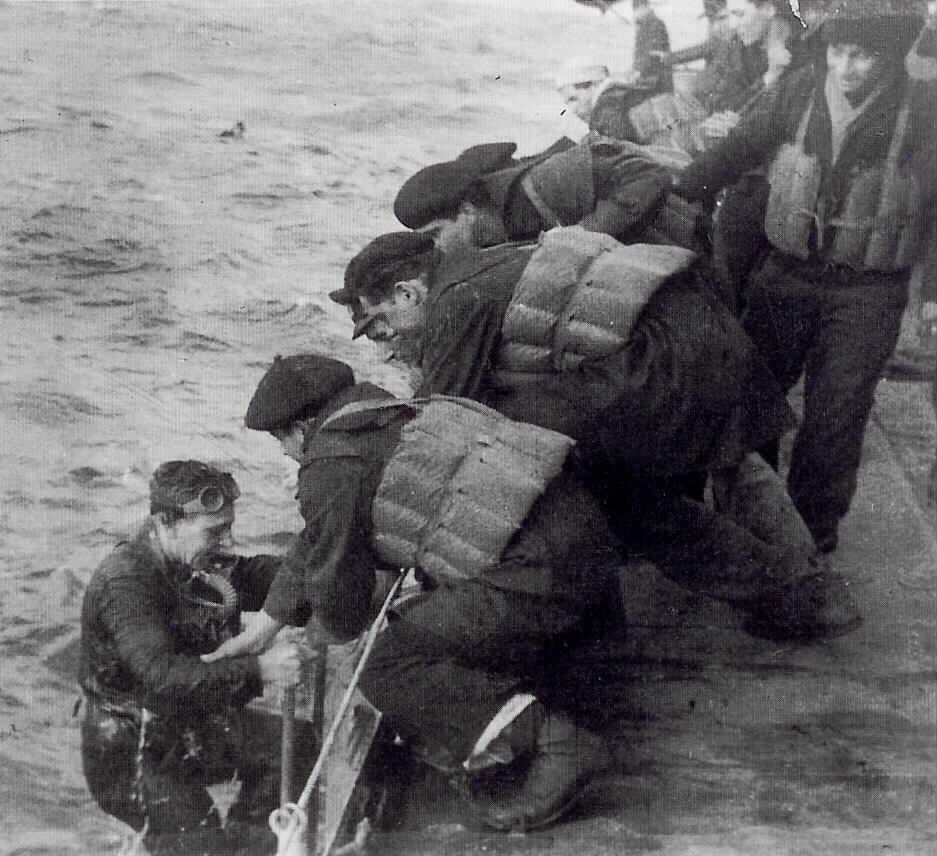

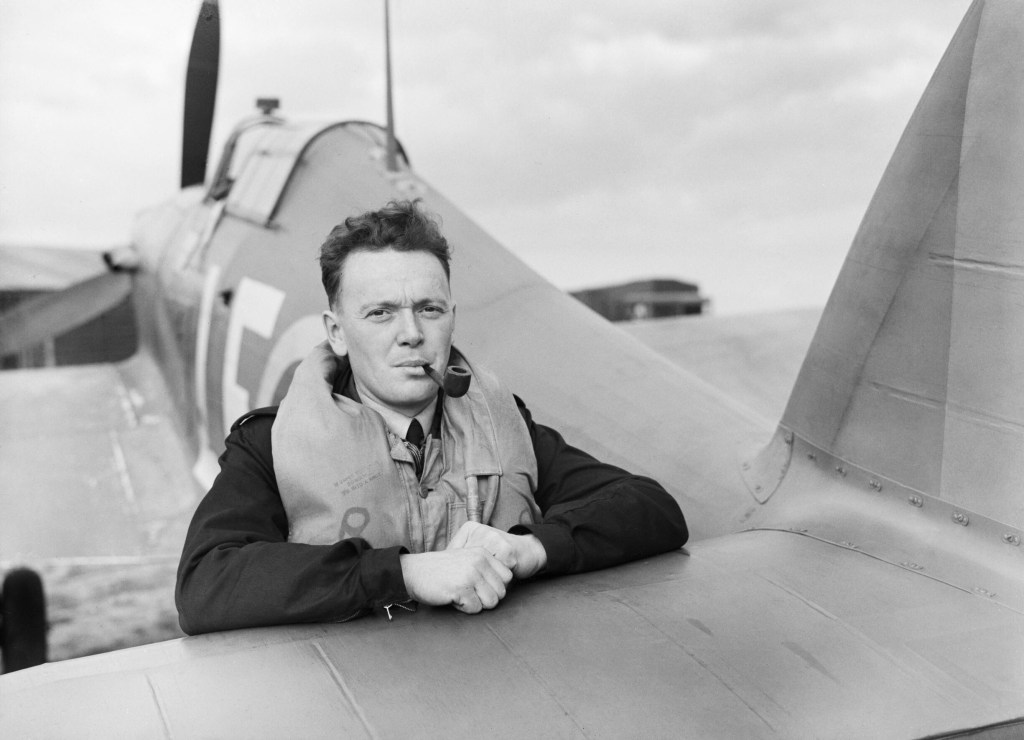
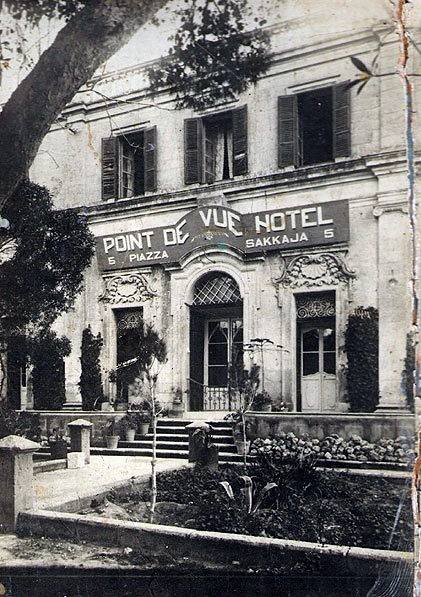
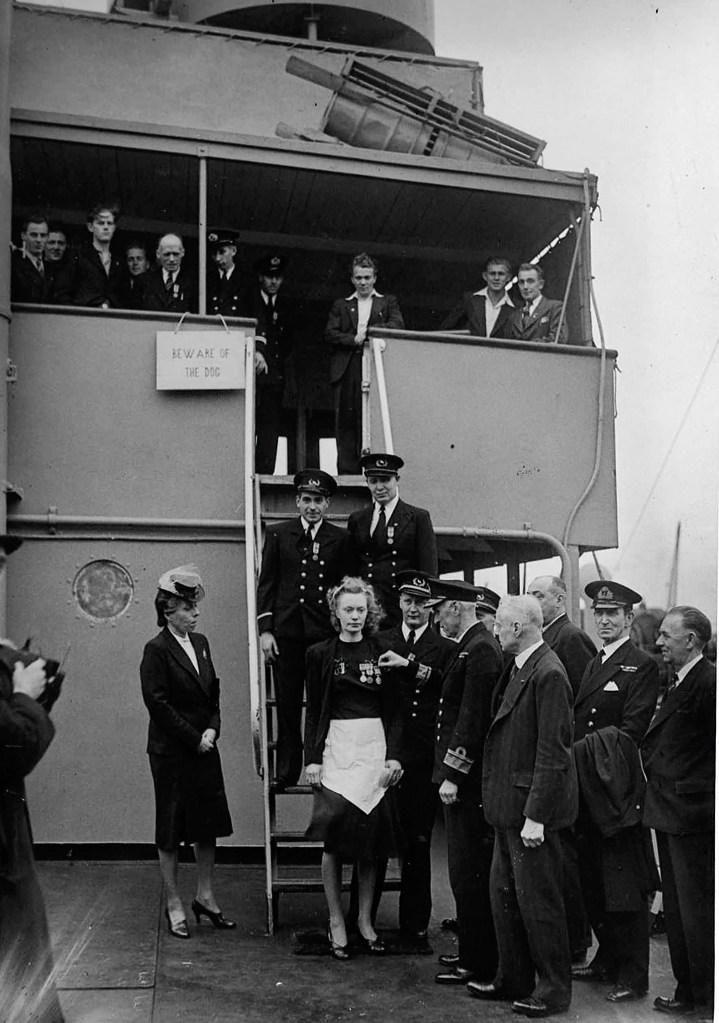

I was very interested to read your notes on Ronald Chaffe. I am currently writing a definitive history of Bristol Rugby Club, and he played one game for us in 1935-36. No official list has survived of the club’s WW2 fallen, but I knew he was one of them. However, I only knew he had died off the coast of Malta, so your notes have been of great value and will be acknowledged in the book. The only other info I have on him is that he attended Cotham School in Bristol and is listed on the war memorial there.
Mark Hoskins
Historian Bristol Rugby
Glad to be of help.
Yeah, Ron Chaffe was a very colorful character. His untimely death was the stuff of a Homeric tragedy. Completely unnecessary.
I have additional information about his time on Malta which could be of interest – although it may not be pertinent to your book.
Thank you so much. Anything else you have would be of interest. I know so little about our WW2 casualties. You may well have a couple of gems I might use.
Hi Mark,
I’m away from home, on assignment, at the moment. I’ll get you more information once I’m back.
Thank you. Absolutely no rush.
I am very interesting in learning when this book will be published.
Thanks for the interest,Steven.
The book is almost complete, but I’ve been caught up in a side book project on nature for an organization – which has taken a protracted amount of time to finish.
Nevertheless, I plan to wrap up “Malta” by June and hope to move it on to the publishing stage by the end of the year.
Thanks for the information. I would be very interested in purchasing a copy if you will let me know who is selling it.
I’ll post the information on this page when it’s out. Thanks.